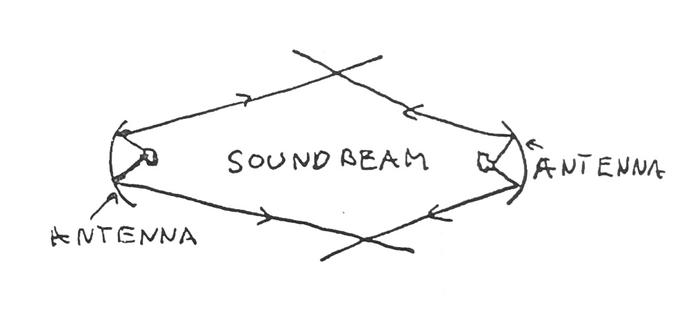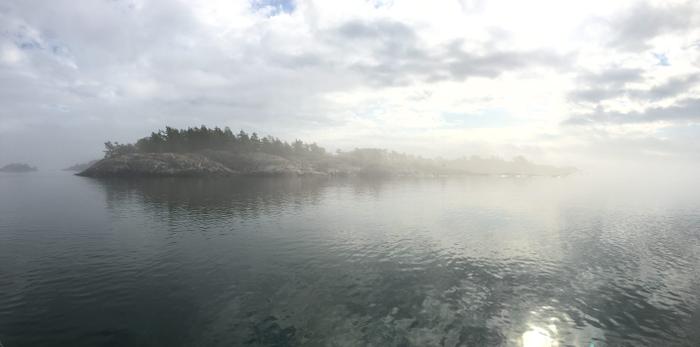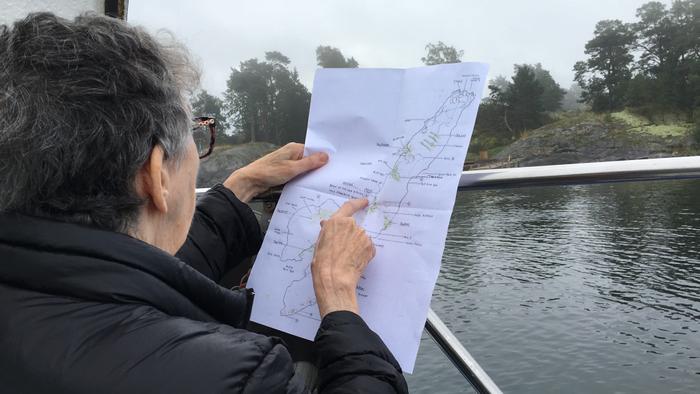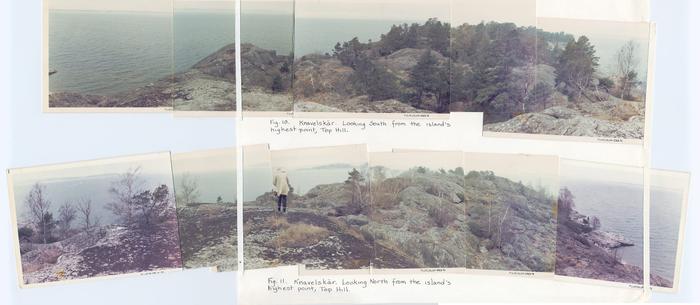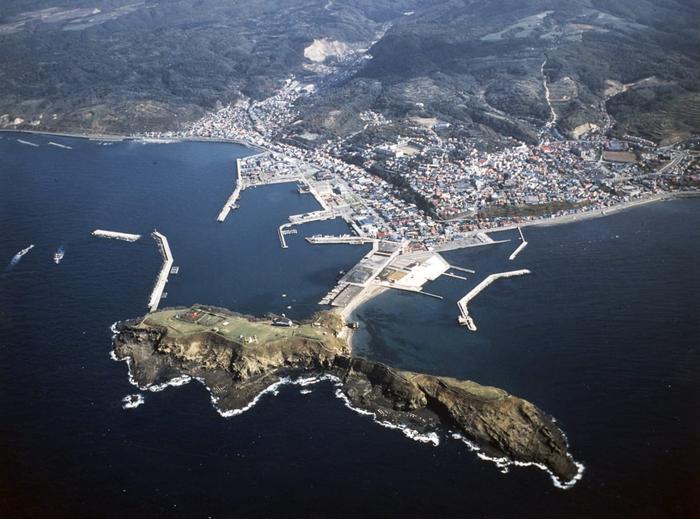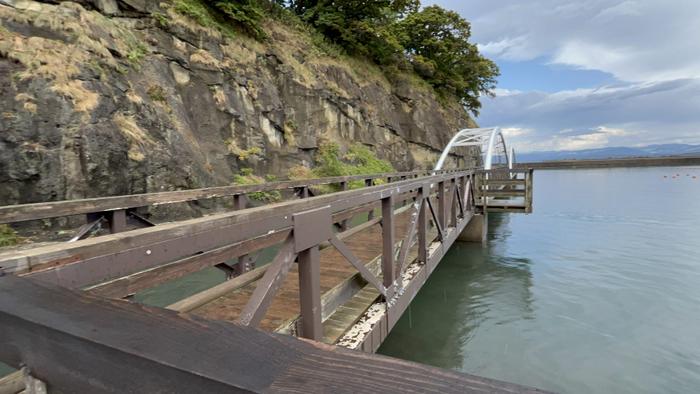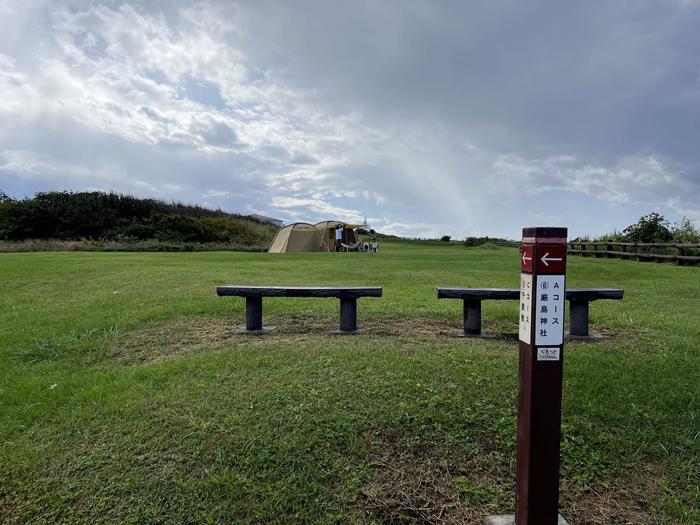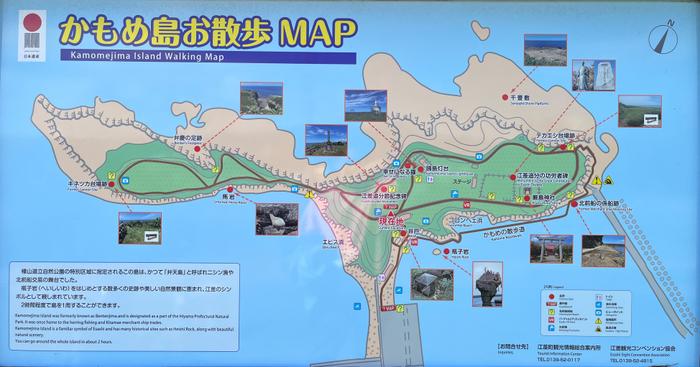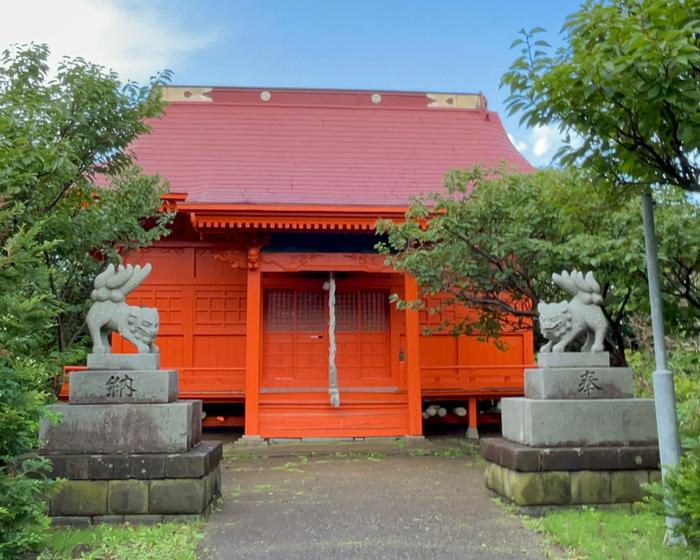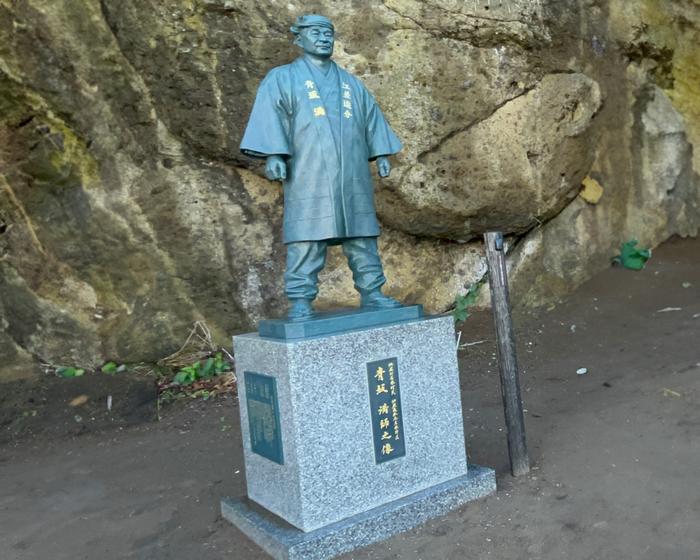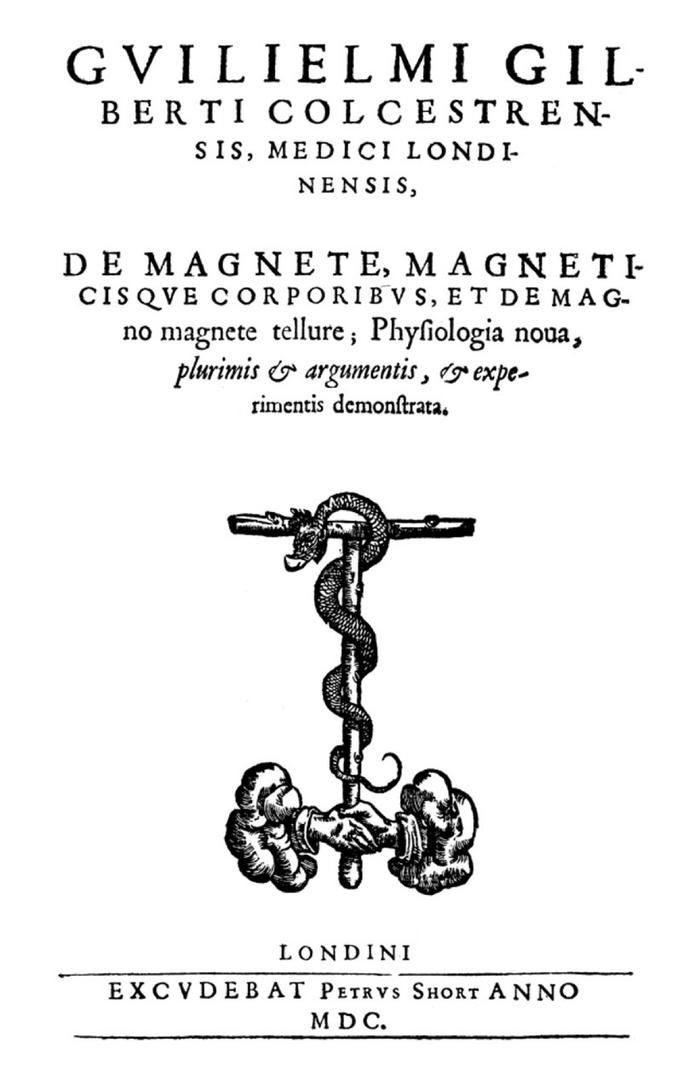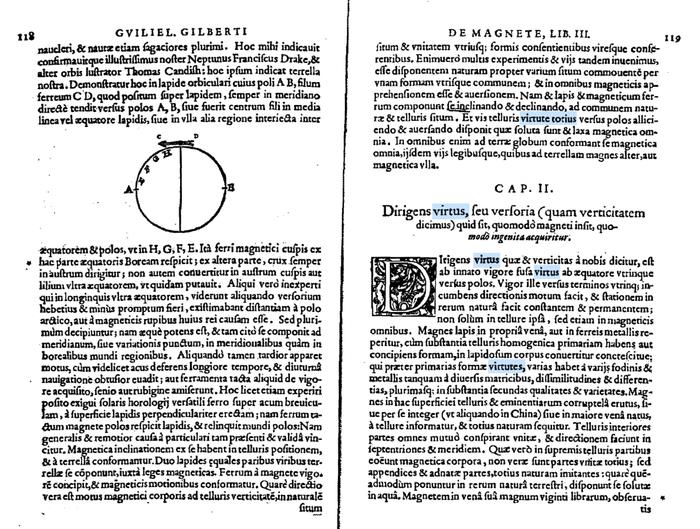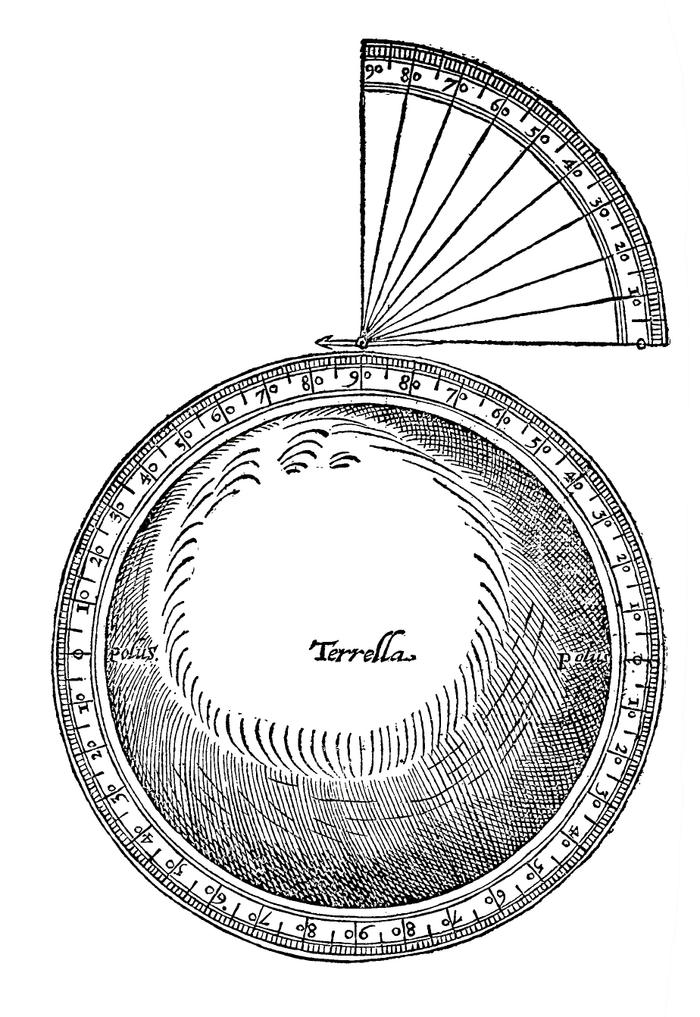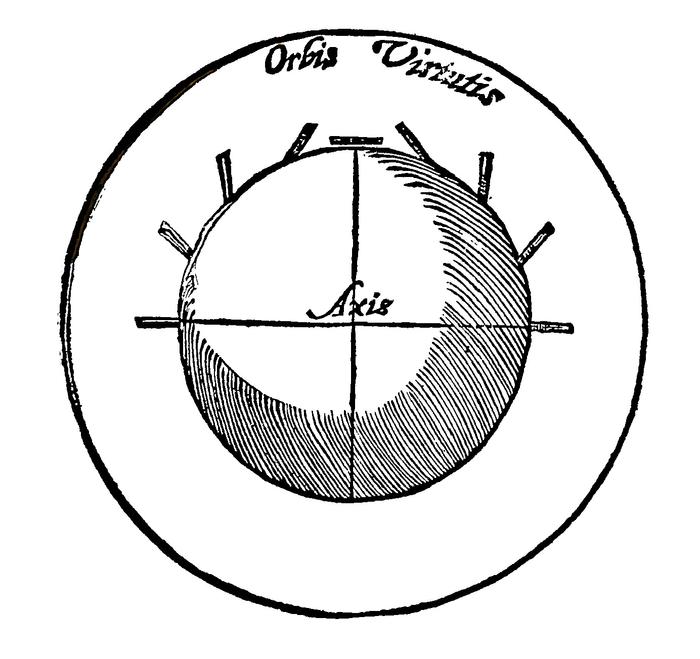
Double exposure effect of sound beam speakers (Photo: Noriko Koshida)

Double exposure effect of sound beam speakers (Photo: Noriko Koshida)
[The following article is composed as an assemblage of seven stories, each of which, due to their relative coherence, could be regarded as islands of narrative, thus forming together a virtual archipelago. I have devised a sequence that I felt worked nicely, but the stories could be visited in several different orders, each route resulting in a different sequence of reflections and return paths. The article as a whole echoes and refracts another article I wrote two years ago titled “Late Realizations.”1]
On 7 July 1974, the experimental musician David Tudor set foot on Knavelskär, an 800-meter-long and 100-meter-wide island in the Swedish archipelago. He was accompanied by a party of four or five people led by Billy Klüver and his assistant Julie Martin, who had been running a group called “Experiments in Art and Technology” (E.A.T.) for about eight years by then to fertilize collaboration between artists and engineers. They carried with them two parabolic reflectors—one of 1.8 meters and the other of 1.2 meters—and a pair of smaller-sized Chinese woks, along with a large amount of electronic equipment and lots of cables. Klüver had many acquaintances in Sweden where he grew up before moving to the U.S., including Jeanette Bonnier, the owner of the uninhabited island who had built a summer house near the South Dock Bay where the party set their base.
For the next two weeks, Tudor and his fellow visitors stayed on the island researching its flora and fauna, landscape and rock formations, weather and wind patterns. Experiments were conducted on the different configurations and positions of parabolic speakers assembled from the equipment they had brought. [Figure 01, 02] Fujiko Nakaya, an artist who had recently begun making sculptures out of artificial fog, flew in from Tokyo for the second week. Margaretha Åsberg, a choreographer based in Sweden, also visited the island and imagined hanging various mirrors that reflected various kinds of light. Tudor had also invited his friend Jackie Monnier, who made art with flying kites, but although she wrote back enthusiastically—“I love the idea of your island project”3—she could not join the expedition.
1 You Nakai, “Late Realizations,” ECHO: A Journal of Music, Thought and Technology 3, 2022, https://echo.orpheusinstituut.be/article/late-realizations.
2 This story revisits the account presented in section 8 of “Late Realizations.”
3 Jackie Monnier, “Letter to David Tudor (June 28, 1974),” Box 56, Folder 5, David Tudor Papers, Getty Research Institute.
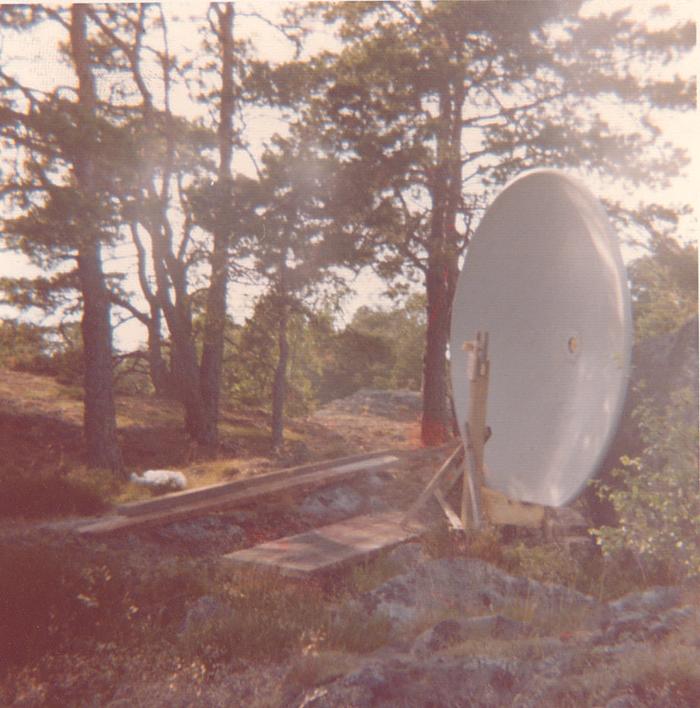
Figure 01: Antenna installation on Knavelskär, July 1974 (Photographer unknown) | Klüver/Martin Archive
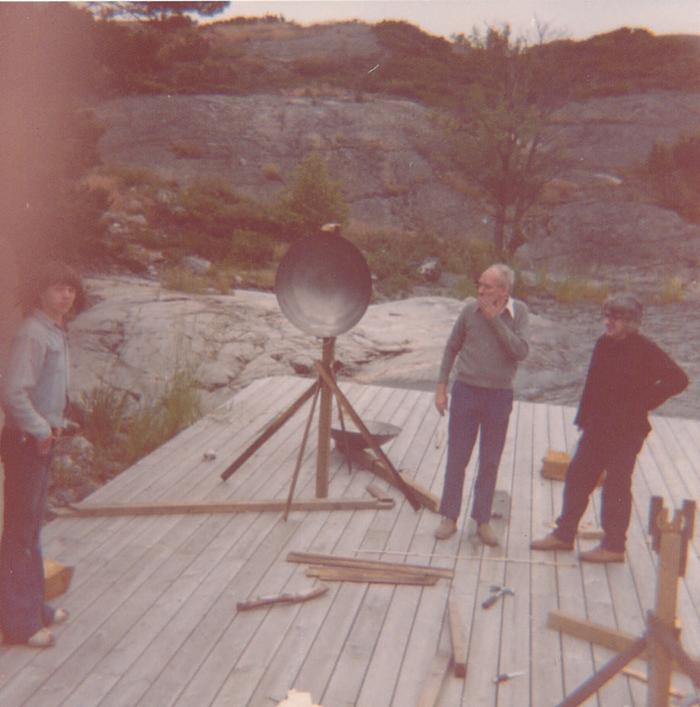
Figure 02: Wok installation on Knavelskär with David Tudor and Billy Klüver, July 1974 (Photographer unknown) | Klüver/Martin Archive
Forty years later, on 7 January 2014, Fujiko Nakaya reflected on how Klüver began searching for an island upon Tudor’s request.4 As far as she could remember, the project had started in the aftermath of the incident at the Pepsi Pavilion, a giant endeavor undertaken by E.A.T. and funded by Pepsi-Cola for the Osaka Expo in 1970. [Figure 03, 04] The unusual collaboration between a profit-seeking corporation dedicated to selling sweet carbonated beverage to the youth and a nonprofit organization dedicated to supporting th most experimental of the arts ended abruptly, when Pepsi-Cola came to its corporate senses and realized that E.A.T.’s interest in advancing art no matter what cost was not serving their interest in advancing profit no matter what art. So four weeks after the opening, E.A.T. and all the artists involved—which included Tudor and Fujiko—were kicked out of the building they had worked on for more than two years. For the remainder of the Expo, Pepsi-Cola simply switched Tudor’s electronic music with the theme song from their previous offering at the 1964 New York World’s Fair, which happened to be “It’s a Small World (After All)”.
4 Fujiko Nakaya, interviewed by You Nakai, Tokyo, Japan, 7 January 2014.
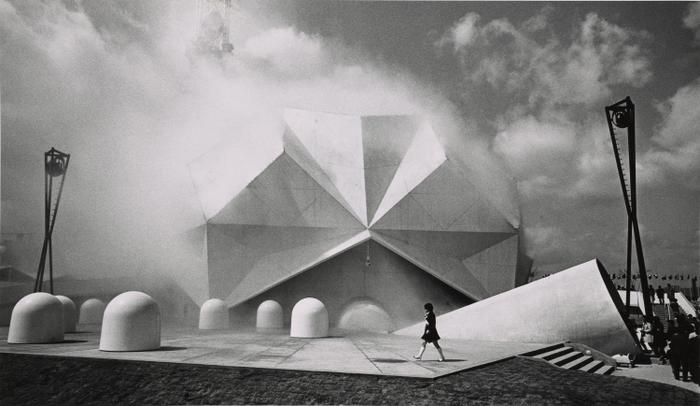
Figure 03: Pepsi Pavilion (Photo: Schunk-Kender) | Klüver/Martin Archive
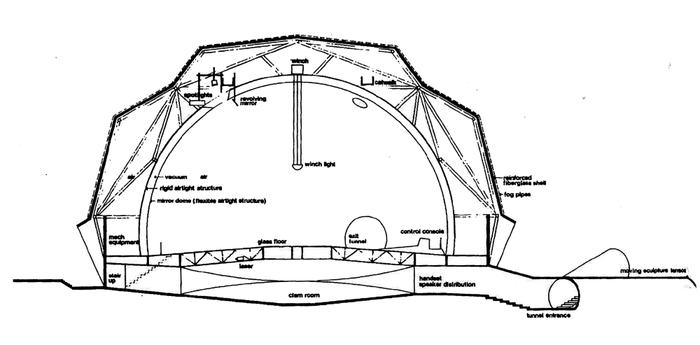
Figure 04: Pepsi Pavilion, diagram | Klüver/Martin Archive
According to Fujiko’s memory, Tudor had a specific thought in mind when he told Klüver what he wanted for his next project soon after their return from Osaka: “They were looking for an island that could be used as a ‘musical instrument.’”5 This was not as far-fetched an idea as it might sound, for Tudor had already been telling people that he had conceived the entire Pepsi Pavilion as a “musical instrument” when he was put in charge of its sound system.6 And you can trace back the origins of this idea to his earlier life as a virtuoso keyboard player who began his career playing the organ, the largest instrument in Western music history which appears to have inspired an idiosyncratic imagery of what a musical instrument is: not something in front of you, but something that surrounds and enwraps you. Tudor’s interest in islands thus made sense: after dealing with a giant man-made architecture of approximately forty-five meters wide and twenty-three meters high, he began contemplating the obvious question of how big an instrument could be. But taking the exploration outdoors, the physical limit could no longer be determined by the physical constructability of the object. This time the instrument would be a “found instrument,” so its size had to depend on something other than how large a person could build it.
Fujiko indeed went on to describe what Tudor imagined as setting the limit, using a rather puzzling set of words: “The particular scale of the place was very important. It was to be an island of a size that matched the maximum scale for feedback to occur. He was looking for a fairly large and elongated island that would take about twenty minutes to get from one side to another and about an hour to go around.”7 The puzzle is not as apparent as it might seem. That Tudor had been devoting himself to the phenomenon of feedback since the beginning of his turn from piano to electronics circa 1958 was no secret. He first became interested in acoustic feedback that occurs when the output of a loudspeaker is returned to an air microphone serving as input to the same sound system; then he began delving into electronic feedback that occurs when the output of a circuit is returned to the input of the same circuit.8 And since the behavior of any feedback system is defined by everything that is inserted in the loop—including the room in which the instrument is located—it was not strange for Tudor to start equating the extent of his instrument to the extent of the feedback loop it activated, which naturally extended further than its physical body. But even with this in mind, there was something quite puzzling in Fujiko’s reflection—that Tudor was after the maximum scale for feedback to occur—which becomes apparent only when the details of what he was planning to do are recovered from the materials left in his archives.9
The outline of what Tudor had in mind in 1974 is not difficult to piece together:
(a) Sound is recorded at different locations on the island in different seasons over a year.
(b) The recorded sounds are played back from highly-directional loudspeakers (created by placing speaker drivers at the focus of parabolic reflectors or smaller woks) installed across the same island.
(c) The parabolic speakers are positioned either in pairs facing each other to compose “sound beams,” or on their own as “sound throws” directed to natural reflectors (such as rocks, trees, hills, and ravines). [Figure 05, 06, 07]
(d) Other than Tudor’s sound beams, artificial fog by Fujiko Nakaya, kites by Jackie Monnier, and mirrors by Margaretha Åsberg are also installed.
(e) Audiences are free to move around the island in any way each person wanted.
The island would thus be covered with multiple sound beams and their reflections playing back the sounds of the same island slightly displaced in time and space. Together with the other components, these sound beams had been selected for one specific reason. Much later in November 1988, Tudor reflected upon the primary component of his instrumentalized island which was always there but never to be seen:
I think that wind is wonderful to use in music. I have an environmental project that I have been thinking about for more than ten years. I don’t know when it will be realized. It uses fog and a sound beam created by two antennae faced to one another. If you are here, you will hear it very loud, if you are there, you will hear it very weak. The wind transforms the sound. If it is really strong in one place, the wind comes and the harmonic content of the sound is displaced. The wind displaces the fog, dissipates it, and reforms it elsewhere. It’s the same thing for the kites.10
5 Ibid.
6 Nilo Lindgren, “Into the Collaboration,” in Billy Klüver, Julie Martin, and Barbara Rose, eds., The Pavilion: Experiments in Art and Technology (New York, NY: E. P. Dutton, 1972), 15.
7 Nakaya, interviewed by You Nakai.
8 The details of Tudor’s exploration of feedback are discussed in Nakai, “Late Realizations.”
9 There are two primary repositories of what Tudor left behind—the instruments are archived at Wesleyan University in Middletown, Connecticut, and the papers along with recordings are archived at the Getty Research Institute in Los Angeles, California.
10 David Tudor, “Interview,” Revue et Corrigée 2 (Spring 1989), 10 (Box 65, Folder 7, David Tudor Papers, Getty Research Institute).
Figure 05: Drawing of sound beam by David Tudor | Klüver/Martin Archive | Courtesy of David Tudor Trust.
Figure 06: Drawing of sound throw (reflected) by David Tudor | Klüver/Martin Archive | Courtesy of David Tudor Trust.
Figure 07: Drawing of sound throw (diffracted) by David Tudor | Klüver/Martin Archive | Courtesy of David Tudor Trust.
As a current of air moving from areas of high pressure to areas of low pressure, wind is invisible. For the human eye, it only appears as a modulation of other appearances. The components of the giant instrument were all sensors of wind in one way or another, making what they sensed sensible to humans through their own audible or visible modifications.11 Fujiko had been describing her fog as a “negative sculpture” for the same reason.12
However, this knowledge of what Tudor wanted to do on the island does not connect well with Fujiko’s recollection of why he wanted to do it. Because no matter how hard you looked into the archived materials, there is nothing in Tudor’s system that made the process repeat itself—there seems to have been no inherent return path. Although he claimed to examine the “maximum scale for feedback to occur” by turning an entire island into an instrument, neither acoustic feedback nor electronic feedback makes any appearance in his plan. In other words, if Tudor was indeed after the limit of feedback, the path that returned the output to the input must have been neither acoustic nor electronic. [Figure 08].
As deceptive as it might sound, it is possible to speculate on an explanation. For there is a single element in Tudor’s plan capable of establishing some sort of feedback, a return path between an output and input despite the separation in time and space. These are the visitors who walked around, listening to sounds and committing them to memory so that they might be matched with another sound heard in another part of the island. A human being could connect space by moving from one place to another, and connect time through the act of reflection. If you are not convinced, recall that Tudor had conceived the entire island as a musical instrument. Given an instrument large enough to enwrap humans, the people inside could easily be regarded as its components. In other words, the estimate for “the maximum scale for feedback to occur,” specified as the particular size and form of the island, may not have been derived from any technical condition of assembled hardware, but rather from the mnemonic condition of expected audiences.
The individuality of experience that each visitor goes through indeed appears to have been the central focus of the project. The very use of extremely localized sound beams certainly attests to this. But when Klüver interviewed him on 24 November 1978, Tudor described what kind of experience he wanted to create in more abstract terms: “First of all, intimacy. So that when you come upon a feature that I’ve arranged within a given space, you feel that you are alone with it. And it won’t matter whether you’re surrounded by people or not.”13 During the same interview, he also described a similar feeling inherent in the nature of the chosen instrument: “I want other people to have the joy of experiencing the absolute uniqueness of an island. When you’re on an island you always feel, no matter how many people are there, that there’s a remoteness which leads you to look very closely at everything there, which you wouldn’t do if you had the feeling that you could go somewhere else.”14 The insular nature of Tudor’s giant instrument would have thus reflected the insular nature of each visitor’s experience.
On the thirteenth day in Knavelskär, the group held a meeting to discuss the concept and the name of their new collaboration. The common goal proposed by Tudor sounded like a contradiction in terms: to reveal the nature of the island using technology. Everyone agreed that “Reflections” was too flat a title, but no one could propose a better alternative.15 Within a month after his return to New York, Tudor came up with a new name. In the first proposal draft, typed on 3 September, the Knavelskär project received the title of Island Eye Island Ear (hereafter IEIE).16 A concert was announced to take place ten months later in July 1975, but Tudor would work for more than ten years for its realization. The plan was to remain unrealized by the time of his death in August 1996.
11 Tudor does not mention Åsberg in this later reflection since she had dropped out of the project in the intervening years, but her hanging mirrors would have been also rotated by wind
12 Fujiko Nakaya, in E.A.T., “Commentary on the Fog Sculpture (1970),” video, process art.
13 David Tudor, “Interview by Billy Klüver (November 24, 1978),” in E.A.T., “Island Eye Island Ear: A Sound and Cloud Environment on Boulder Island (January 11, 1979), Appendix I,” Box 21, Folder 8, David Tudor Papers, Getty Research Institute.
14 Ibid.
15 E.A.T., “Report on Experiments for ‘Knavelskär’ Project (August 8, 1974),” Box 21, Folder 1, David Tudor Papers, Getty Research Institute.
16 E.A.T., “Proposal for Island Eye Island Ear (September 3, 1974),” Box 21, Folder 1, David Tudor Papers, Getty Research Institute.

Figure 08: Map of Knavelskär showing sound beams (blue arrows), sound throws (red arrows), and areas of fog (green shades) created by David Tudor, Fujiko Nakaya and Margaretha Åsberg | Klüver/Martin Archive
On 2 September 2019, I received an email from Julie Martin asking me if I wanted to join an expedition to Sweden she was about to make with a group of younger artists.18 For the first time in forty-five years she was revisiting Knavelskär, the island she had visited for two weeks in the summer of 1974 to explore the realizability of an unusual concert plan conceived by her friend David Tudor. I had recently finished the manuscript of my book on Tudor’s music which included a chapter on Island Eye Island Ear, where I had told the story of missing feedback and discussed the issue of reflection that appeared to lie at the heart of the project.19 But I had never been to the actual island—that idea had somehow never crossed my mind. The visit was taking place in a week and I was 12,000 km away in Tokyo. As a good student of chance operations, I decided to do rock-paper-scissors with my ten-year-old son Aevi and go if I win and stay if I lose. I won and hopped on the plane.
As we approached Knavelskär—which happened to be quite beautifully covered in fog [Figure 09]—I handed Julie a printed copy of the map they had made during the first expedition. Looking at it, she attempted to superimpose the images in her memory from almost half a century ago onto the scenery spreading before her eyes in the present [Figure 10]. This act of reflection continued throughout the several hours that we stayed on the island, as we walked by the trees and rocks and ravines, around the beaches and inlets, with Julie constantly projecting what had stayed in her mind after all these years. It was a feedback of mind that may have been on Tudor’s mind when he decided to explore the “maximum scale for feedback to occur,” though the scale of its realization most likely exceeded his rather modest expectations. As if to reflect Julie’s experience of creating a virtual double exposure of Knavelskär, one of the photographs I took turned out to be the exact same location that Fujiko had photographed forty-five years before to create a 360-degree composite picture. [Figure 11, 12]
17 The story revisits the account presented in section 10 of “Late Realizations.”
18 The members were Anna Lundh, Jacob Kierkegaard, and Tobias R. Kirstein.
19 You Nakai, Reminded by the Instruments: David Tudor’s Music (New York, NY: Oxford University Press, 2021), Chapter 6.
Figure 09: Knavelskär, September 2019 (Photo: You Nakai)
Figure 10: Julie Martin looking at the map of Knavelskär from 45 years before (Photo: You Nakai)
Figure 11: Composite photograph of Knavelskär from the island’s highest point, Top Hill, July 1974 (Photo: Fujiko Nakaya) | Klüver/Martin Archive |
Figure 12: Photograph of Knavelskär from the island’s highest point, Top Hill, September 2019 (Photo: You Nakai)
When I sent a brief report of our revisit along with several photos we took to Fujiko, it appeared to have triggered a reflection on her part as well, for she suddenly decided to invite Julie to Japan to discuss the realizability of IEIE in January 2020. We organized a conference in Kaga, a city in Ishikawa prefecture where Fujiko was collaborating with the artist Kenjiro Okazaki to set up a research institution named Kagakuukan to foster collaboration between art and engineering.20 I was told that this platform could serve as our base for the island project in Japan. Shortly before we got there, however, we were informed that there was not a single island in Kaga, neither in the city nor its immediate vicinity. [Figure 13]
So after we were done with the conference, Julie and my family took a day trip to search for an island in the surrounding prefectures. The excursion was lovely but ended up being futile as far as finding a giant instrument was concerned. The unexpected byproduct of our revisit to Knavelskär seemed to have been pointless. I felt bad having invited Julie all the way across the ocean only to have her return, yet again after all these years, without an actual island in sight. But somewhere along the way back to our hotel, Julie had a moment of reflection about the nature of this project that she had been involved in for more than four decades. She turned to me and said, “Maybe Island Eye Island Ear is now this whole process of trying to find an island!”21 I laughed and agreed wholeheartedly, without any idea of what that process might have in store.
20 This institution began its activity in January 2019, and the IEIE conference was the second annual conference that we organized. It would also be the last gathering before the pandemic, and the endeavor appears to have lost its momentum now. Most of the information about Kagakuukan is in Japanese, but there is an English version of the website that includes an essay I wrote about my trip to India: You Nakai, “On the Many Vehicles of India,” Kagakuukan, 2019, https://kagakuukan.org/eng/texts/on-the-many-vehicles-of-india.
21

Figure 13: Flyer of “Weathering ear, Breathing eye” conference (2020) at Kagakuukan
On 18 October 2021, Hiroko Myokam, a curator based in Kaga who had been involved in organizing our Island Ear Island Eye conference a year before, suddenly contacted me asking if I was interested in joining a new multi-year project in Hokkaido, the northernmost island of Japan. She had been invited by SIAF-Lab, a team of artists and engineers based in the capital city Sapporo, who provided technical support to the local triennial named the Sapporo International Art Festival (SIAF). The four members—Norimichi Hirakawa, Kei Komachiya, Katsuya Ishida, and Daisuke Funato—were concerned about the way SIAF was organized as a once-in-a-three-year festivity to attract visitors for a short moment yet leaving not much behind for the local people to appreciate in the long run. They had heard complaints from citizens who did not understand why the city should spend tax money on such a pointless extravagance that appeared to give not much in return. Unlike all the other artists and curators who just came and went for each festival, the members of SIAF-Lab all lived in Sapporo, which meant they were left to live with this problem, the only ones to do so since even the city officials in charge of the festival also ended up just coming and going for each festival due to the constant transfer from one government section to another. Given this situation, they decided to engage in a long-term project that took place during the two years between one festival and another, which focused on a more intimate connection with the local community. When they invited Myokam to be the curatorial researcher for this new endeavor, she proposed to explore the realizability of IEIE in Hokkaido. SIAF-Lab had been invested in projects dealing with the relationship between technology and nature, and they were interested in David Tudor, so this sounded like a great plan.
I accepted the invitation, of course, but proposed a small twist to reflect on the particular sequence of events that had led us to explore the possibility of realizing IEIE in Hokkaido of all places. Since it all seemed to be a chain of one byproduct after another, I suggested that this project should focus not only on realizing the island project from half a century before but also on the side effects that would inevitably emerge in the attempt to do so. We decided to name the island part of the project IEIE, Reflected, but to call the entire endeavor Side Project to remind ourselves of our concern for peripheral events that the focus on set goals tends to obscure. And off we went to search for an island that we may turn into a giant musical instrument.22 [Figure 14]
22 Over the two years, we organized four exhibitions/symposiums to present the development of the project: IEIE, Reflected | Phase 1 consisted in a public experiment of ultrasonic sound beams at Moerenuma Park (designed by Isamu Noguchi) as well as the exhibition “IEIE Chronicle,” where we reflected on the history of IEIE through a collection of short stories (28 August 28–4 September 2022); Phase 2 was an exhibition titled “Location Hunting” where we presented a series of interviews with people we had met during our endeavor to look for an island (4–14 February 2023); Phase 3 was a symposium we organized titled “No Wo/Man Is an Island: From Knavelskar to Kamomejima” (27 November 2023), where Side Project members presented separate accounts of IEIE in Kamomejima, and the connection between IEIE and LIAF was discussed by Marianne Hultman and Kjersti Solbakken, who were visiting Hokkaido to witness the test run (with Berte Ynnesdal, the producer of LIAF); Phase 4 was titled “Virtual Ground” and consisted in the presentation of Virtual IEIE at Hokkaido University along with the symposium “Virtual Grand Hotel” (18 February 2024), which brought many of the people we had met over the past two years in Hokkaido together in one place for the first time.
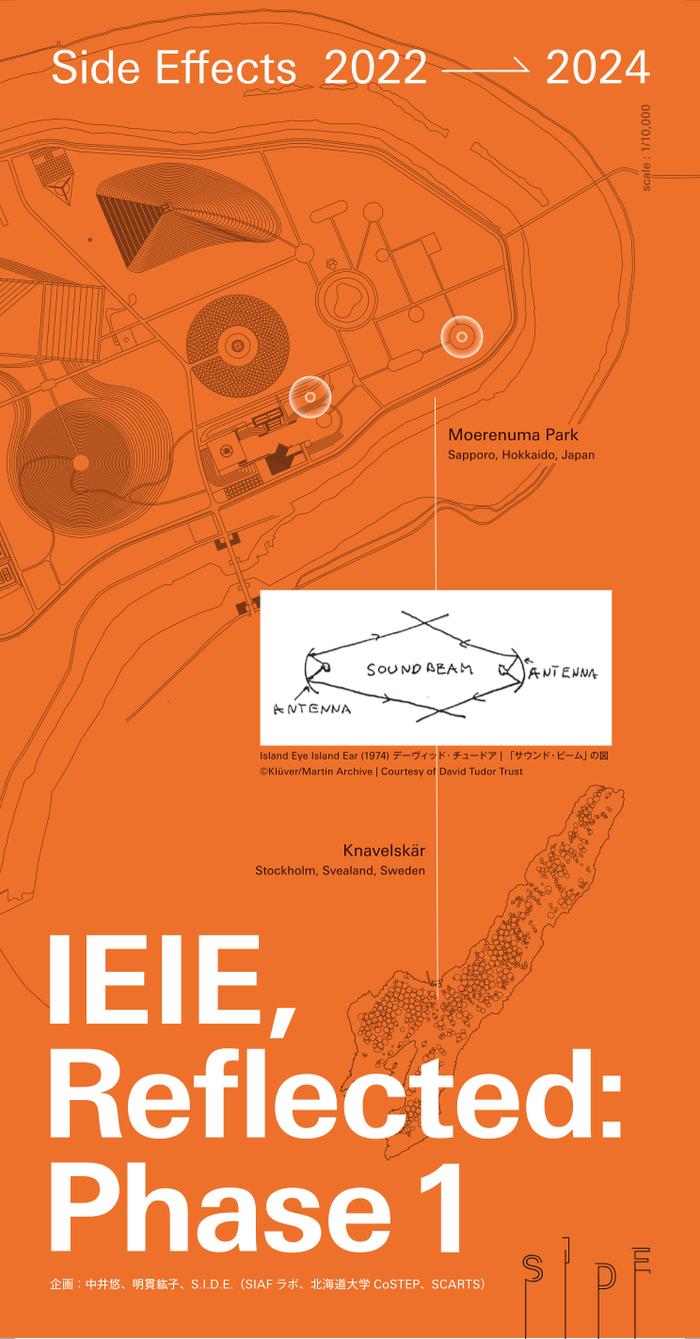
Figure 14: Flyer of IEIE, Reflected: Phase 1 (2022) by Side Project
After a year of searching that took us all over Hokkaido, we came across an island named Kamomejima (“seagull island”) located off the coast of the town of Esashi, approximately 260 km south of Sapporo. 1000 meters long and 200 meters wide, this island was a bit larger than Knavelskär yet very similar in its elongated form, as well as having an elevation of thirty meters in the middle, which corresponded nicely to the eighteen-meter-high Top Hill of the Swedish counterpart. As far as its geographical nature was concerned, it appeared to be a virtual Knavelskär in slight miniature. [Figure 15]
But one particular nature of Kamomejima bothered me at first: its sheer proximity to the town with which it was literally connected via a sandbank built in the 1920s and now covered in concrete. In all the documents about IEIE that I had laid my eyes on, the islands that were considered for the project were all uninhabited and described as a pristine environment. Kamomejima, in stark contrast, was deeply entangled with the lives of Esashi citizens, who took daily strolls along the boardwalk that surrounds its northeastern periphery [Figure 16], organized summer festivals in the field above the Top Hill that was also used as a campground [Figure 17], fished along the concrete pier on the northern tip, and collected seaweed on the western coast where a vast rocky terrain spread, flattened by waves across millennia. [Figure 18]
Such intimate connections with the local community extended beyond the present, as this island was also immersed in records of human activity across history, a presence of the past that was apparent mainly in two forms. The first was buildings or remains thereof that people had installed into the landscape: a Shinto shrine built in 1615 for wishing maritime safety for fishermen [Figure 19]; remnants of holes and rings in sites where incoming merchant ships were moored during the Edo period (1603–1867) [Figure 20]; two former cannon forts for guarding the coast installed in 1852; a monument for Esashi Oiwake—a particular form of folk song developed in Esashi and known throughout Japan—erected in 1932; and a statue of Mitsuru Aosaka, the famous virtuoso singer of this folk song, next to the house at the start of boardwalk where he used to live and where his family still does. [Figure 21]
Figure 15: Photo of Kamomejima
Figure 16: Kamomejima boardwalk (Photo: You Nakai)
Figure 17: Kamomejima Top Hill field (Photo: You Nakai)
Figure 18: Kamomejima map (Photo: You Nakai)
Figure 19: Kamomejima Shrine (Photo: You Nakai)
Figure 20: Nineteenth-century photograph of ships moored at Kamomejima
Figure 21: Statue of Mitsuru Aosaka (Photo: You Nakai)
The second form of past in the present was the stories and names that people had projected onto the landscape: the giant circular rock in front of Aosaka’s house was known as Heishi Iwa (“bottle rock”), from the legend of an old woman who is said to have thrown a magic bottle into the sea to gather a huge shoal of herrings 500 years ago [Figure 22]; the rocky platform on the western coast was called Senjojiki (“1000 tatami mats”) because that’s how it looked [Figure 23]; the Uma Iwa (“horse rock”) on the southeastern part of the island was said to be a fossilized horse waiting for the return of his master, a famous military commander from long ago who happened to stop by the island; and the giant hole on the southwestern coast was named Benkei no Ashiato (“the footprint of Benkei”) after the warrior monk who served this commander and followed him up north. What shaped the particular nature of this island was therefore not simply its flora and fauna, its landscape and rock formations, its weather and wind patterns—it was also people and their everyday lives, their desires and beliefs, their language and music. No wonder Esashi promoted Kamomejima as “an island enwrapped with nature and legends,”23 although perhaps more accurately, it was an island whose nature was enwrapped with legends. A virtual dimension of narrative filtered the visible landscape creating a double exposure effect.
23 Esashi Town Office, “Komomejima Island,” portal site for the tourist information of Hokkaido Esashi, https://en.esashi.town/tourism/page.php?id=8.
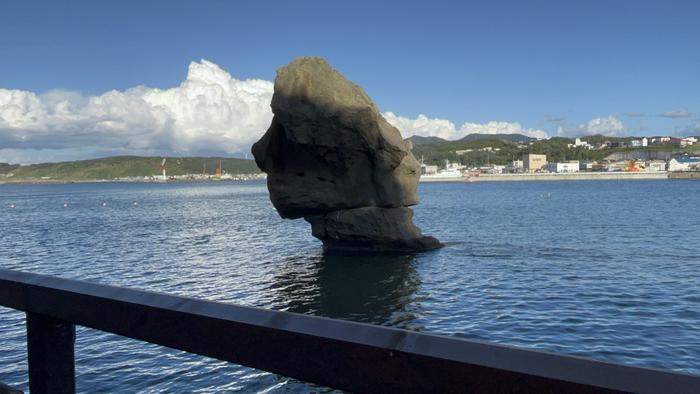
Figure 22: Heishi Iwa (Photo: You Nakai)
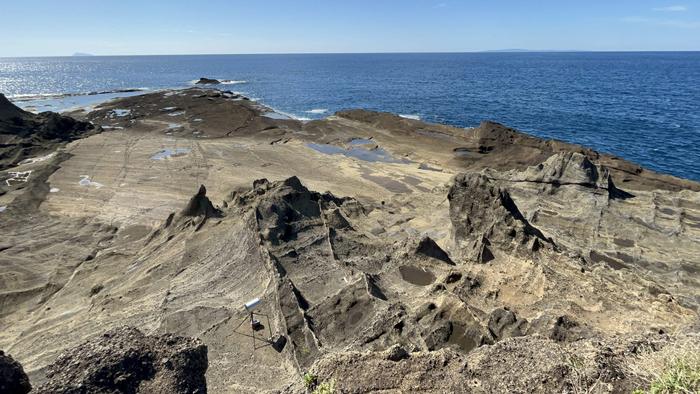
Figure 23: Senjojiki (Photo: You Nakai)
So we had to make a choice: whether to continue looking for the ideal island that exactly matched the imaginary island Tudor had in mind fifty years before—an ordeal that might take us another fifty years—or to make do with the island we found. Alongside the search for an island, we had developed our version of sound beams that used parametric speakers emitting ultrasonic waves beyond human audible range that were brought down to audible range whenever they hit a physical object.24 [Figure 24, 25, 26] This was not the technology Tudor planned on using in the 1970s, but it did everything he wanted as far as sound was concerned. However, we had not yet obtained the kites or the fog. Since our version was going to be partial anyway, I decided to dismiss the missing ideal and focus on what we presently have at hand. Even if the conditions were not perfect, we might learn something by actually realizing some version of IEIE, which we could apply on the next island we may find.25
Once we made that decision, it became apparent that we needed to regard the history of Kamomejima as part of the nature that IEIE would seek to reveal. There was no other way since Tudor’s plan required you to engage with the specificity of the found island. One of his directives, for instance, was to record various sounds at different locations on Kamomejima in different seasons over a year. When we tried to do this in July 2022, we could not help but record the sounds of the summer festival that was going on at the time. Otherwise, it was hard to miss the music from the statue of the virtuoso singer Aosaka, equipped with a small button that tourists and passersby pressed incessantly to play a recording of his performance (and virtually reenact his daily habit of singing to the seagulls). And it was impossible to ignore the legend of the magic bottle as we pointed a sound beam to Heishi Iwa as a natural reflector. So the activities of people constantly blended with nature, and the stories about the island became one with the island—they could not be kept apart.
24 One unexpected discovery we made was that there is a prominent interest in high-directional speakers all over Hokkaido. There is a kit of ultrasonic speakers that you can buy in Tokyo for about 100 dollars, which is used quite often in sound art. When we started looking into this kit, we realized that the company that makes them, called Tristate, is based in Tomakomai, which is a town in Hokkaido. We also found a professor in Sapporo whose research consists in putting giant parametric speakers on cars to chase away wild animals while driving.
25 I discuss this aspect of experiment in an upcoming essay about Experiments in Art and Technology: You Nakai, “The Missing Parts: E.A.T. Records (and Sets the Record Straight),” Sensing the Future: Experiments in Art and Technology (E.A.T.) (Los Angeles, CA: Getty Research Institute, 2024).
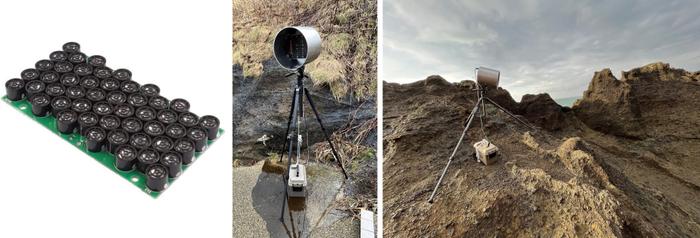
From the left: Figure 24: Parametric speaker unit sold by Tristate. Figure 25, 26: Parametric sound beam speakers on Kamomejima (Photo: You Nakai)
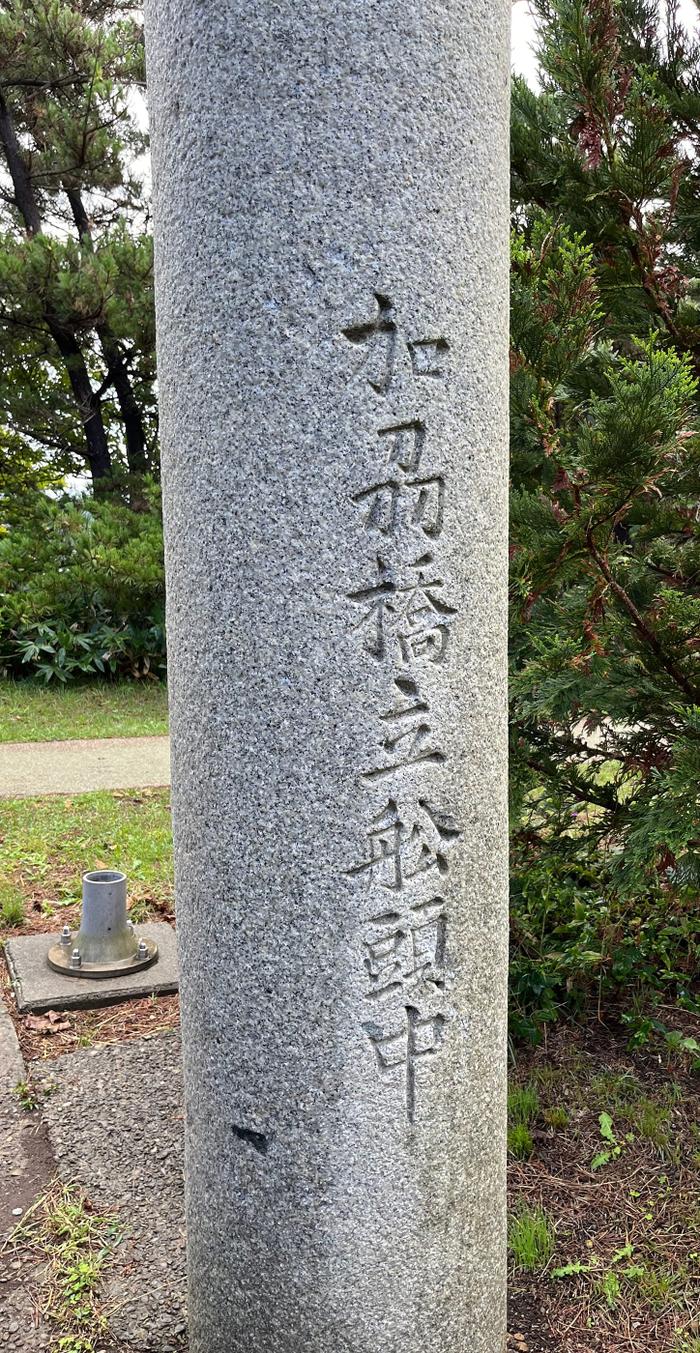
Figure 27: Stone pillar with the inscription “Boatmen of Hashidate village, Kaga” (Photo: You Nakai)
But that was not all. For as we delved deeper into its history, we learned that this island we encountered by sheer chance happened to have an intimate connection with Kaga, the town where I had first entertained the possibility of realizing IEIE before coming to Hokkaido. The merchant ships that were moored here during the Edo period carried goods from Ishikawa prefecture, and you could actually read the name of Kaga in an old stone pillar erected next to the island shrine. [Figure 27] Esashi-Oiwake had first grown out of folk songs that traveled with the sailors on these ships, so its roots could be traced back to an area of mainland Japan that included Ishikawa. By taking IEIE from Kaga to Kamomejima, we had inadvertently revived the old transmission route of music. I had never imagined such a fantastic return path.
At the same time, we were getting to know the local people of Esashi, all of whom began feeding us more stories that revealed further connections between Kamomejima and IEIE. We learned that Esashi was known in Hokkaido as a town of strong winds, and Kamomejima had acted as a natural windshield throughout its history. Takashi Matsumura, one of the oldest citizens, was an amateur photographer who had recorded the town history since the 1960s, especially focusing on the long-term effect of wind on trees.26 [Figure 28, 29, 30] He took great interest in what we were doing after hearing rumors about it in a local bar, and became more interested in me after he found out that my mother’s maiden name was also Matsumura. The ninety-eight-year-old doyen—who happened to be born in the same year as David Tudor—told me half-jokingly after a few rounds of Japanese sake that we must be distant relatives, and gave me a book he had written based on his extensive research on the roots of the Matsumura clan.27 Another unexpected return path, this time to the history of my family that I was completely unaware of.28
But amid all the excitement, one serious problem emerged: it turned out that we could not install IEIE on Kamomejima during the next Sapporo International Art Festival. For one thing, Esashi was a five- hour drive away from Sapporo where the festival was happening. We thought of organizing bus tours and joked that I would have to give a very long lecture about IEIE, Reflected during the trip. But even if we did that, we would still have to face the fact that the island along with all our equipment, was going to be covered in snow in February, the coldest month of the year SIAF happened to be taking place in.
The difficulty of realizing IEIE in winter was indeed an issue we struggled against throughout the project. I learned that many islands in this part of northern Japan cease to be islands once a certain threshold of coldness is crossed. Lakes would freeze and seawaters would roughen, making enclaves either vanish or out of reach. And even more generally, it’s no secret that a piece of land appears and disappears often depending on the shifts in levels or states of the surrounding water. The presence of an island thus seemed to be a matter of effect rather than of substance. In other words, I began to realize that the issue of virtuality lay at the bottom of the project that placed focus on the specificity of an island.
But as we switched our plans from staging IEIE in Kamomejima to staging some documentation of IEIE in Kamomejima in Sapporo, something unexpected happened: we were contacted by the Department of Engineering at the University of Hokkaido, which had recently built a 360-degree theater where multiple people could experience virtual reality without putting individual headsets on. Through the university’s partnership with SIAF, they were letting us use this VR theater for the presentation of IEIE, Reflected if we wanted. I hesitated, thinking that the most important thing about IEIE is experiencing the actual island. Playing a recording of that experience appeared to defeat its purpose. But as time pressed on, I had to accept the fact that there was no other good choice. So in the end, I gave in. As a byproduct of choosing Kamomejima as our instrument, we suddenly had to turn IEIE into a virtual reality piece.
26 When Klüver interviewed him on 24 November 1978, Fujiko revealed her interest in a mode of reflection that was much longer in scale than what Tudor had in mind: “I have studied the island features for three days and imagined the way it might have been a thousand years ago and how it might be in one thousand years from now. I want to sensitize people to the different features that one can experience beyond a present time experience of the island—not just the flaming leaves but the features that are timeless or change over a long time period—the way the wind reacts to the contours of the island, the way the trees are bent by the wind” (Fujiko Nakaya, “Interview by Billy Klüver (November 24, 1978),” in E.A.T., “Island Eye Island Ear: A Sound and Cloud Environment on Boulder Island (January 11, 1979), Appendix I,” Box 21, Folder 8, David Tudor Papers, Getty Research Institute). The bent shape of the tree is the result of all the winds of the past that have blown over this tree. In this case, reflection would transcend the here and now, thus opening up a path for the possibility of IEIE that extends beyond the individual experience of David Tudor.
27 Takashi Matsumura, Genryu: Donba-mura, Nambu Somafu no Keifu (Upstream Origin: The Genealogy of Donba Village and the Lumberjacks of Nambu) (Esashi, Hokkaido: Hifuusha, 2016).
28 Yet another unexpected byproduct was my acquaintance with Hiroshi Watanabe, a tabla performer and a househusband living in Sapporo, whose interest in David Tudor’s music prompted him to purchase my 768-page book even though he could not read English, and proceeded to type out each and every word so that he could upload the text to machine translation and render it into Japanese. He spoke to me when we did our first symposium about the project in February 2021 and began participating in all the IEIE, Reflected events we subsequently organized in Sapporo. When we chose Kamomejima as the site, he was surprised since his father had been a singer of Esashi-Oiwake and he had grown up hearing that music. He joined us for our test run in November 2023 and talked with Matsumura, who recalled his father visiting Esashi frequently in the past.

From the left: Figure 28, 29: Photograph of trees bent by wind in Esashi (Photo: Takashi Matsumura). Figure 30: Photograph of a tree bent by wind on Bluff Island, one of the locations researched for IEIE in 1978 (Photographer unknown) | Klüver/Martin Archive
In the fall of 1950, David Tudor was nervous as never before. He was scheduled to give the American premiere of a piano sonata composed by a young French composer named Pierre Boulez on 17 December at Carnegie Hall. Known as a brilliant virtuoso who could perform any difficult score with utmost ease and precision, Tudor was a stranger to stage fright. It was because of this that he had been introduced to John Cage, a composer who had brought back the score of the Second Piano Sonata from his recent trip to Paris. People had told Cage that Tudor was the “only one person in America who could play” this music.30 But this time around, things did not proceed as usual. For no matter how hard he practiced, Tudor could not get through the Boulez piece. The problem was not that the piece was technically too difficult; it was that there seemed to be nothing holding the pieces together, as Tudor reflected later in May 1972:
I found a sort of constant breakdown in the continuity. […] Boulez had written no counterpoints, no second voices, and you couldn’t subordinate any voices at all, as there was nothing leading, nothing on which the music centered itself.31
With the material presenting no continuity of its own, the solution had to be sought elsewhere. As time pressed on, with less than a month left for the concert, Tudor desperately looked around for any other material that could help him. One day, as he skimmed through a French article that Boulez had written about modern rhythmic organization using the Second Piano Sonata as an example, his eye caught a passage toward the end where the composer brought up another author as the model for his approach: “I think that music should be collective hysteria and magic, violently modern—along the lines of Antonin Artaud.”32 Tudor had most likely never heard Artaud’s name before. But he rushed to obtain a copy of Le Théâtre et son double, the major treatise on theater that this French theater director/actor had published in 1938. [Figure 31] Then he took his French dictionary out and began reading in earnest. The book worked quite literally like magic, as Tudor continued to reflect in May 1972:
I read a lot of Artaud and I began to understand the intention of the musical continuity. […] I realized I was now in a different situation, in the presence of a different type of musical continuity than I was used to, and all of a sudden I was able to play it.33
The details of what sort of magic Tudor discovered in Le Théâtre et son double belong to another story, one that has already been told elsewhere.34 What matters for us now is that the act of reading Artaud to play Boulez produced an unexpected byproduct whose influence would reach far beyond the performance of a difficult piano piece. For in the third chapter of Le Théâtre et son double, Artaud had coined a novel term to describe the workings of the particular kind of theater he envisioned. And when Tudor recommended the book to the poet M. C. Richards, his partner at the time, she went on to translate the book, thereby introducing the same term to the Anglophone world. [Figure 32] In chapter 3 of Theater and Its Double, published in 1958, we can witness the first appearance of réalité virtuelle rendered into English:
All true alchemists know that the alchemical symbol is a mirage as the theater is a mirage. And this perpetual allusion to the materials and the principle of the theater found in almost all alchemical books should be understood as the expression of an identity (of which alchemists are extremely aware) existing between the world in which the characters, objects, images, and in a general way all that constitutes the virtual reality of the theater develops, and the purely fictitious and illusory world in which the symbols of alchemy are evolved.35
29 The second part of this story revisits the account presented in section 9 of “Late Realizations.”
30 David Vaughan, “Interview with John Cage, 1978-12-20/1979-01-18,” Merce Cunningham Dance Foundation Collection, New York Public Library.
31 David Tudor, “From Piano to Electronics,” Music and Musicians 20 (August 1972), 24.
32 This was Boulez’s first published article: “Propositions,” Polyphonie 2 (1948), 65–72. The English translation is included in Pierre Boulez, Stocktakings from an Apprenticeship (New York, NY: Oxford University Press, 1991), 54.
33 Tudor, “From Piano to Electronics,” 24.
34 Nakai, Reminded by the Instruments, 84–89.
35 Antonin Artaud, Theater and Its Double, translated by M.C. Richards (New York, NY: Grove Press, 1958), 49. Italics added.
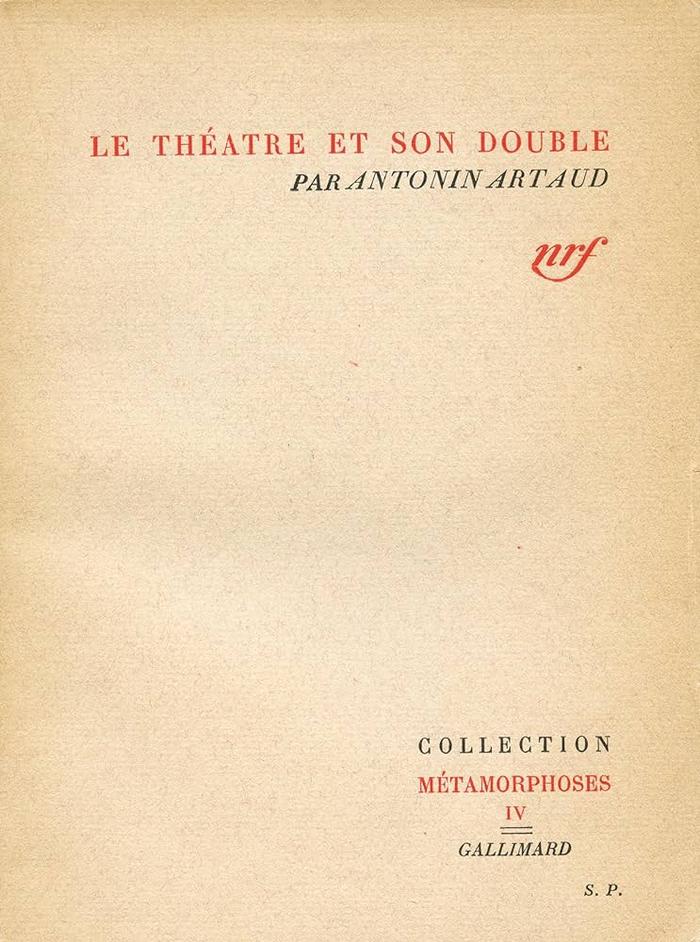
Figure 31: Le Théâtre et son double

Figure 32: The Theater and Its Double
The term remained in Tudor’s mind until much later. When his plan to turn an entire island into a musical instrument faced difficulties, he focused on a series of new music that appeared to realize the ideas he had developed for IEIE in a different manner. For instance, around the same time as his visit to Knavelskär, Tudor began giving frequent performances of Rainforest, a piece where found objects were converted into loudspeakers by attaching transducers to them. In each concert, the object-speakers would be scattered around the space, hanging from the ceiling, and he soon began describing this instrumentalized forest as if it were a miniature analog of the instrumentalized island—a virtual IEIE, so to speak—as he did on 3 September 1984, recalling the same word that had occupied him in Knavelskär: [Figure 33]
[T]he purpose of the contact mike is to take the resonant frequencies which you hear at best very close to the sounding object; to take those into an ordinary loudspeaker which you can consider not as auxiliary but as enhancement. What that does when you establish the proper tonal balance is that you’ve got a reflection of the sound which you can distance in space. […] [The piece] becomes larger and there’s a coherence there that’s deceptive which I like very much because as you move through the space there are sounds that you hear, that you’ve heard before or have heard somewhere else.38
36 Austin Clarkson, “Composing the Performer: David Tudor Remembers Stefan Wolpe,” Musicworks 73 (Spring 1999), 32.
37 For a critical discussion on the semantic shift that virtus underwent in the seventeenth century, which also manifested itself in the figure of the modest gentleman-scientist who observed how “natural” forces work across distance—“he reported on the world, not on himself”— and the complex relation of this shift to issues of gender, race, and social hierarchy, see Donna Haraway, Modest_Witness@Second_Millenium.FemaleMan_Meets_OncoMouse (London: Routledge, 1997)38 David Tudor, “ ‘…Performing Is Very Much Like Cooking: Putting It All Together, Raising the Temperature’: An Interview with David Tudor by John David Fullemann in Stockholm, May 31, 1984,” David Tudor Pages website, http://davidtudor.org/Articles/fullemann.html. Although the interview is dated 31 May, this could not have been true since Tudor was nowhere near Stockholm on that day. Fullemann talks about “the performance last night” at the start of the interview, which he clarifies as referring to Tudor’s concert of Dialects at the Moderna Museet in Stockholm. Tudor indeed performed Dialects in Stockholm in 1984, but that was on 2 September, which reveals the interview to have taken place the following day, 3 September 1984.
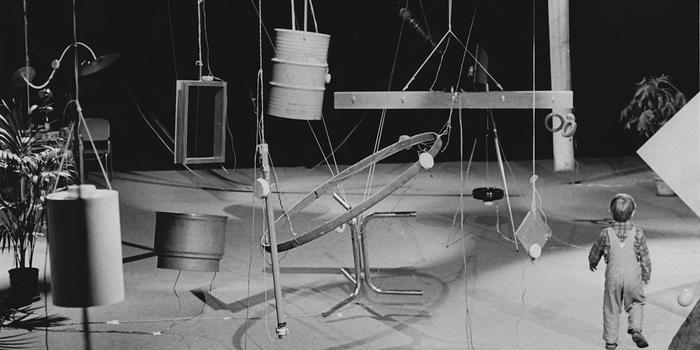
Figure 33: Rainforest IV at L’Espace Pierre Cardin, Paris, 1976 (Photo: Ralph Jones)
Sonic reflection thus triggered mental reflection—it composed a “deceptive coherence” in the mind of each moving visitor, fabricating an illusory continuity that was not in the materials.
In parallel to Rainforest, Tudor began to engage in another series of virtual IEIE with Monnier, where he swapped sound beams with radars that emitted radio waves to her kite-like objects hanging from the ceiling to capture their movement (driven by artificial wind from a fan) through reflection, and used that information as control signals to modulate his sound. [Figure 34, 35] All the pieces in this series carried the word “reflection” somewhere in the title. But as Tudor moved from one piece to another, a different term was introduced to address the same illusion. When he was commissioned new music from the choreographer Merce Cunningham in 1989, Tudor decided to redirect the same radars to human dancers on stage. The title he chose to describe what he was doing, with beams that could neither be seen nor heard, did not connect well with the digital simulations of three-dimensional environments created by computer technology that was becoming a fad at the time, but opened a return path to Tudor’s own past life as a pianist: Virtual Focus.

Figure 34: Diagram of 9 Lines, Reflected by David Tudor | Courtesy of David Tudor Trust

Figure 35: David Tudor and Jackie Monnier performing Volatiles and Sonic Reflections at Jack Tilton Gallery, New York, March 1990 (Photographer unknown) | Klüver/Martin Archive
In 1600, the English natural philosopher William Gilbert, who served as a personal physician to Queen Elizabeth I and King James I, published a book titled De magnete, magneticisque corporibus, et de magno magnete tellure (On the Magnet and Magnetic Bodies, and on the Great Magnet the Earth).39 [Figure 36] In it he developed what would later be considered the first scientific research on magnetism and electricity, both forces that work across distance and produce particular effects on its receiver. But readers well-versed in the contemporary literature of alchemy, magic, or astrology should have noticed a continuity with the past rather than a radical break. This is because Gilbert’s immediate precursors, who are often categorized as belonging to the Renaissance era, were also fascinated with forces that work from afar: how an object exposed to the sun becomes warm as if some of the star’s qualities were imparted upon it; or how a viewer of a painting painted with pigments created from rocks or plants that had absorbed the rays of specific celestial objects would receive some of the same qualities carried across the chain of intermediary materials.40 These flows of quality between entities were grouped under the common rubric of influentia—meaning something that flows—and served as the basic operative model for astrologers, magicians, and alchemists alike.
So if there is one thing that stands out in De magnete, it is the fact that this critical term is missing from its pages. Throughout the treatise that expands across six books, influentia makes only a few appearances. But there is another word that takes its place as if it were its double: virtus. [Figure 37] This substitution triggers a shift in focus, since influentia refers to the substance that produces the effect, whereas virtus alludes to the potential.41 Such sleight of hand seems to have been a reaction to the contemporary rise of a mechanistic worldview, which relied on explanations based on the direct physical contact of its components—even if these mechanisms were entirely imaginary, as was often the case42—and ridiculed explanations based on the workings of imperceptible rays that moved things from afar.
Not that Gilbert was simply meddling with metaphysics to argue something he could not lay his hands on. He did happen to believe that the Earth itself was a giant magnet, but designed many experiments to prove his point, using a small spherical magnet he called the terrella, or “small world”—a virtual miniature of the planet, endowed with the same virtues, except smaller in scale. [Figure 38, 39] Such experiments, displaying the working effects of virtus with instruments devised for that purpose, would become popular among England’s natural philosophers throughout the seventeenth century, all the way to Isaac Newton and his law of universal gravitation, encompassing the entire trajectory of what some call the Scientific Revolution.
39 William Gilbert, De magnete, magneticisque corporibus, et de magno magnete tellure (London: Peter Short, 1600).
40 For a good overview, see for instance Mary Quinlan-McGrath, Influences: Art, Optics, and Astrology in the Italian Renaissance (Chicago, IL: University of Chicago Press, 2013).
41 In the English translation of De magnete by Silvanus Philips Thompson, published in 1900 as On the Magnet, virtus is often translated as “influence.” Paul Fleury Mottelay’s translation, which was published in 1893, also translates Gilbert’s term orbis virtutis as “sphere of influence.” See On the Magnet, translated by Silvanus Phillips (London: Chiswick Press, 1900), and De magnete, translated by Paul Fleury Mottelay (New York: Dover Publications, 1991)
42 For instance, see René Descartes, Principia philosophiae, 1644.
Figure 36: William Gilbert, De magnete (London: Peter Short, 1600).
Figure 37: The appearance of “virtus” in De magnete.
Figure 38: Drawing of the terrella.
Figure 39: Drawing showing the orbis virtutis—or “the sphere of influence”—around the terrella (both from De magnete)
But England in the seventeenth century was an island tormented by other kinds of revolution as well. When the Parliamentarians opposing Charles I—the son of James I to whom Gilbert served as a personal physician—captured the king and beheaded him in 1649, this turn of events caused an unexpected byproduct in the history of music. For once the monarch was out, all the arts that they had patronized had to go as well. That included the Crown’s Music, a band of virtuoso musicians that the royal court had amassed from all over Europe, which was disbanded in 1646 making performers of the highest caliber suddenly in need to secure a source of income. Many of them decided to do something that had never crossed their minds before: to perform for the general public. As Penelope Gouk who studied this transition in detail explained, the venue for these unprecedented concerts had to be improvised:
One of the most important musical innovations of the seventeenth century was the commercial music meeting, usually located in a tavern room, where an entrance fee was charged for participants and auditors. These semi-private events began simultaneously in Oxford and London during the late 1640s.43
And among the drunk audiences placed under the influence of virtuosic music in Oxford taverns, there must have been natural philosophers devoted to experiments to display the workings of virtus. Although their endeavors were still not part of the university’s formal curriculum, “the most distinctive feature of Oxford ‘scientific’ life was the habit of small groups of like-minded individuals to meet informally on a regular basis to perform experiments and discuss their findings.”44 One of these meetings that ran weekly from 1649 was called the Experimental Philosophical Club, and when the monarchy was restored in 1660, its members sought the approval of the new king to turn their club into something official. The result was the Royal Society, known as the world’s oldest academic society, but also the latest theater of virtual effects performed with virtuosic precision and ingenious instruments in front of an audience eager to be entertained.
43 Penelope Gouk, Music, Science and Natural Magic in Seventeenth-Century England (New Haven, CT: Yale University Press, 1999), 43.
44 Ibid., 41.

Figure 40: Air pump, from Robert Boyle, New Experiments Physico-Mechanical, Touching the Spring of the Air, and its Effects (H. Hall: Oxford, 1660).
In their 1985 book Leviathan and the Air-Pump, Steven Shapin and Simon Schaffer focused on the seventeenth-century debate over a series of experiments Robert Boyle conducted at the Royal Society using a mechanical instrument, called the air pump, which created states of vacuum inside a glass container by sucking all the air out. [Figure 40] Noting the contrast between Boyle’s indecisive attitude about the explanation of the mechanism behind the phenomena and his decisive belief that the phenomena itself is an incontestable “matter of fact,” the two late-twentieth-century authors reflected across the distance of three centuries to witness a novel attitude to knowledge that placed faith on concrete happenings rather than abstract theories.45 What mattered was how nature behaved on its own, not the virtual dimension of narrative that people superimposed on it. This understanding of acts of nature as a fact rather than an act would go on to define the field of practice that became known as the natural sciences. But it would also form a potent narrative of its own, influencing how people thought about experiments in general, all the way to a twentieth-century virtuoso dedicated to experimental music, one who wished to turn an entire island into a musical instrument by revealing the hidden natures of a pristine landscape.
Both the members of the Royal Society and David Tudor resorted to technical instruments for this purpose. Yet, Shapin and Schaffer observed, such matters of fact were not produced by material technology alone. In addition to the construction and operation of instruments such as the air pump, there had to be a social technology that institutionalized the conventions of what an experiment should be and how people should behave during it—hence the need for a club and a society.46 But that was not all either, since social technology led directly to the question of who could attend these experiments to bear witness. And here things got a bit complicated. For one thing, the Royal Society admitted only male aristocrats, although nobody at the time thought that was a problem.47 The issue was not that people who were not allowed to be there could be absent, which seemed like a matter of fact; it was that people who were allowed to be there, and even expected to be there, could nevertheless be absent for various reasons. The condition of being situated in one location in time and space made it impossible to gather all the necessary audiences for any given experiment.
Hence, Boyle came up with a contrivance: he devoted considerable time developing a literary technology by means of which the “matter of fact” produced in an experimental setting could be re-experienced by potential audiences who could not be there in person. The specific format of the report he devised for this purpose went on to be known as academic writing. Shapin and Schaffer, who produced a dense academic treatise reflecting on this particular origin story of their craft, gave an alluring name to the intended readers of these texts which opened a return path to the spectacular forces that entertained viewers at the actual site of experiment: virtual witness.48
45 Simon Schaffer and Steven Shapin, Leviathan and the Air-Pump: Hobbes, Boyle, and the Experimental Life (Princeton, NJ: Princeton University Press), 1985.
46 Ibid., Chapter 2.
47 Donna Haraway has offered an important critical analysis of the complicity between the model of unbiased modest witnesses who happened to be all white male aristocrats and the idea of equally unbiased and incontestable “matters of fact.” This closed circuit served as a pretext to claim that whatever happened in the experimental setting was done by nature and not men. In contrast to the idea of neutral objectivity derived from such an attitude, Haraway conceived of objectivity from the standpoint of being situated in specific time and space. See Haraway, Modest_Witness@Second_Millennium. FemaleMan_Meets_OncoMouse TM: Feminism and Technoscience, Chapter 1; Donna Haraway, “Situated Knowledges: The Science Question in Feminism and the Privilege of Partial Perspective,” Feminist Studies 14-3 (Autumn 1988), 575–599.
48 Schaffer and Shapin, Leviathan and the Air-Pump, 60–65.

Figure 41: Flyer of IEIE, Reflected: Phase 4 | Virtual Ground (2024) by Side Project
Between 22 and 26 November 2023, Side Project performed an experimental “test run” of IEIE on Kamomejima. On 16 and 17 February 2024, the same group staged a virtual reality piece titled Virtual IEIE at the 360-degree virtual reality theater at Hokkaido University. [Figure 41] The following is a report of what we did, along with some reflections on why we did so, written for those who could not be there in person.
For the test run, we installed the parametric ultrasonic speakers we had built in different locations on Kamomejima and had them each beam out a sound we had recorded on another part of the same island in different seasons over a year. We had decided that it would be better to establish a fixed route going around the northern half of the island in a loop, rather than to let visitors wander off aimlessly on their own. For one thing, we did not have enough sound beams to cover the whole island. For another, if we were going to stick to Tudor’s request—as relayed four decades later by Fujiko—that the size of the island should be “twenty minutes to get from one side to another, and about an hour to go around,” the entire Kamomejima was too big. So our loop covered only half of it, taking about thirty minutes to go around. This was shorter than what Tudor had in mind, but it seemed just right given our shortage of sound beams and lack of kites and fog. Moreover, knowing the trajectory of people’s movements certainly made it much easier to choreograph the trajectory of their experience. Since the island was now conceived as a musical instrument, we set to compose its internal circuitry.49 [Figure 42]
Even after we decided not to show what happened on Kamomejima to direct witnesses, but to present a recording of whatever happened on Kamomejima to virtual witnesses, we kept the loop idea since it made clear what needed to be recorded. But when we installed the sound beams on the island for the test run, I realized that there was a fundamental problem about turning IEIE into a virtual reality piece. For we were now hearing seagulls squawk from giant rocks, the ghostly sounds of last year’s festival in an absent field, the buzzing and rasping of spring insects in winter, and Aosaka’s song on the wrong side of the island. The realization of what Tudor only had in mind resulted in casting an unnatural veil of natural sounds onto the soundscape.
To be sure, this was exactly the effect that Tudor had explained in the interview with Klüver on 28 November 1978: “[M]y intention is to take a sound which lives there naturally in a very definite environmental situation and to put it into another environmental situation so that the way you experience the same sound is slightly transformed by a different environment. In that way you don’t forget the sound; it lives with you in different ways.”50 I must have read that passage a hundred times, yet the reality of the effect he imagined didn’t quite hit me until I actually experienced it myself. What I realized was that this contrivance resulted in disorienting not only the experience of sound but also the experience of the whole environment. This was an environment that had grown quite complex, with sound beams scattered all over a landscape already covered with stories and man-made buildings. And after being inside this environment—which is to say inside this particular musical instrument—for some time, I noticed that even the supposedly natural sounds started sounding as if they were sound beams coming out of one ultrasonic speaker or another. Curiously, adding a virtual layer of sound had the effect of making real sounds appear virtual. The physical nature of the island thus ceased to be a solid reality—it was as if all matters of fact had become matters of act. In other words, it finally dawned on me that IEIE was a virtual reality piece to start with.
49 We started the loop from the statue of the virtuoso singer Aosaka, pressing that little button to play back his song that conversed with seagulls. Then the route traveled through the boardwalk going around the northeastern periphery of the island, first passing by the Heishi Iwa (bottle rock), which would reflect sounds of seagulls recorded in summer, and continuing onto the long concrete pier, where another sound beam would be emitting sounds of a ship horn recorded in fall. In between there would be a small inlet where the buzz of spring insects refracted and resonated in a complex manner. From there, visitors would climb a flight of stone steps leading up to one of the former cannon fort sites, before heading down to the rocky platform on the west coast that looked like 1000 tatami mats. Several sounds—including the recording of the played-back recording of Esashi-Oiwake—would be repeated in multiple locations to facilitate the return path through reflection. The loop ended by climbing to the Top Hill field, where sounds of a bygone summer festival were heard next to a bell that SIAF-Lab members named “For Whom the Bell” after a poem by the English poet John Donne about an island not really being an island because it is connected to the continent underwater. Walking down another flight of stone steps from that field brought you back to the house of Aosaka. The loop could then replay over and over like a reel tape that once documented the singing of the virtuoso who lived there.
50 Tudor, “Interview by Billy Klüver,” 1.

Figure 42: Map of Kamomejima depicting the loop with the placement of sound beam speakers, created by SIAF-Lab.
Hence, at the center of our conundrum was a problem of nesting: how do you create a virtual reality of virtual reality? Usually, people think of virtual reality as something that simulates the experience of a non-virtual reality as accurately as possible, or fabricates one that feels as real as possible. This was indeed what SIAF-Lab began working towards: record everything with a 360-degree camera in high-resolution, project the film in a 360-degree theater, and calculate the correct direction of sounds to simulate the entire soundscape via multiple surrounding speakers in accordance with the projected visuals. But the obvious problem with this approach was that it may revive the non-virtual reality of Kamomejima, but not the disorienting relationship between the non-virtual and virtual realities of the island that formed the reality of Island Eye Island Ear.
For one thing, the effect of parametric speakers produced by inaudible beams hitting physical objects in the same space could not be simulated in the playback of a recording from regular speakers. For another, the displaced origin of sound beams such as a seagull squawk from a giant rock could be easily explained by attributing it to some bird that happened to be outside the frame. So all the contrivances for disorienting the relationship between what is deemed real and what is deemed virtual on the island were flattened into a single layer of reality that people inside the theater regarded as virtual in contrast to their own non-virtual reality. That is to say, the distinction between the two levels of reality did not waver for visitors of Virtual IEIE, as it did for visitors of IEIE.
It seemed to me that the only way to simulate the reality of IEIE was to compose a similar disorientation that took place on Kamomejima to take place in Sapporo. The theater had to be turned into a virtual island. So I came up with several contrivances of my own, three to be exact. The first concerned the content of virtual reality: to edit the recording in a way that visitors would be reminded that the appearance of reality is an appearance only. In any case, the shortage of available parametric speakers—we only had six51—meant that we had to divide the loop into different scenes that are recorded separately and later combined to create the illusion of a single loop. So during the test run in Kamomejima, we did multiple takes of each scene, walking the same loop segment several times with a 360-degree camera: some with people and some without; some under the sun and some under the rain; some in midday and some in dusk. And then I created a loop patching these scenes together. Instead of using a crossfade function to smooth out the transition between scenes, I superimposed the end of one scene over the beginning of another, adjusting their transparency rate so that the two appeared in double exposure. [Figure 43, 44] What resulted was a fictitious trip around Kamomejima that no one had actually experienced before.
51 To distinguish the speakers which looked identical, we decided to give them names, following the example of Tudor, who named one of his horn speakers “George.” Ours received the names of the original members of IEIE: “David,” “Jackie,” “Fujiko,” “Billy,” and “Julie.” For the last one, SIAF-Lab insisted that it should be “You”—I objected but could not come up with a better substitute, so the name remained.

Figure 43: Double exposure effect in Virtual IEIE (Photo: Noriko Koshida)
Then I made another loop that had people in it, in contrast to the first loop, which showed a completely vacant island. But since the end of the first loop was superimposed onto the beginning of the second, it would initially appear as the repetition of the same. You had to stay inside the theater for some time to realize that it was not. And then I made two more loops by flipping the entire film horizontally so that you were now experiencing the island in a mirror image. For those who had never been to Kamomejima, the signs describing the legends and names of specific sites now appeared in mirror writing to indicate that the world had been flipped.
The second contrivance focused on the relationship between virtual and non-virtual reality. One prominent nature of our 360-degree film was that it constantly moved forward along the loop, which meant it had a strong directionality that visitors would perceive as “front” despite the theater being circular. With this in mind, I made the entire footage rotate very slowly, six degrees per minute so that it took thirty minutes to turn 180 degrees, which essentially converted the theater into a giant clock—if it were seen from above. But for the visitors inside, since there is a considerable lack of external reference points to reflect on their physical orientation in a theater surrounded by images, I imagined that they would unconsciously adjust their bodies to match the “front” direction while everything rotated. Thirty minutes happened to be the length of each loop, so if the “front” was facing north in one loop, it would be facing south in the next one. There were two doors to the theater, made out of the same metal material as the rest of the wall so that when images were projected they became difficult to notice. Disoriented visitors were likely to look for the exit based on their memory and not find it.
The third contrivance dealt with the content of what visitors deemed as non-virtual reality. I incorporated “behind-the-scenes narrations” that appeared during some loops but not others, consisting of different people talking about Kamomejima and the things we did there from various perspectives.52 The narrators inside the theater would be among audiences, and since their presence was not announced anywhere in the program, visitors would perceive their narration as a part of their own reality in spite of it framing the experience of virtual reality with language. To emphasize this impression, the narrators always addressed a specific person in the audience, though others could eavesdrop if they wanted. If recorded in advance, they were played back from the two parametric speakers we brought inside the theater so that narration would be heard only by the person who happened to be in the pathway of the sound beam. Putting the speakers in the space meant that they would at times be superimposed on the speakers in the image, creating yet another instance of double exposure.53 [Figure 45]
52 Hiroko mainly focused on the relationship between Kamomejima and Kaga; SIAF-Lab members talked mostly about the technology of ultrasonic speakers; I alternated between stories about IEIE and reading passages from The Invention of Morel, a novel by Adolfo Bioy Casares published in 1940, about an island in which recorded events from the past are constantly replayed as holographic virtual reality.
53 All in all, my intention was to take what I deemed to be the nature of “virtual reality,” which was the turning of a first-person experience into a variable that can be substituted by different individuals, and use this condition as a decoy to stage the merging of what was deemed virtual and what was deemed non-virtual. Such substitution of experience appeared similar to the function of “shifters” in linguistics, words that change their meaning depending on the situational context, like the first-person pronoun “I” that each speaker must substitute to compose a narrative, or the second-person pronoun “you” that each reader must substitute to follow a narrative thus composed. In either case, a prepared absence is filled in by some individual situated in a specific time and space.
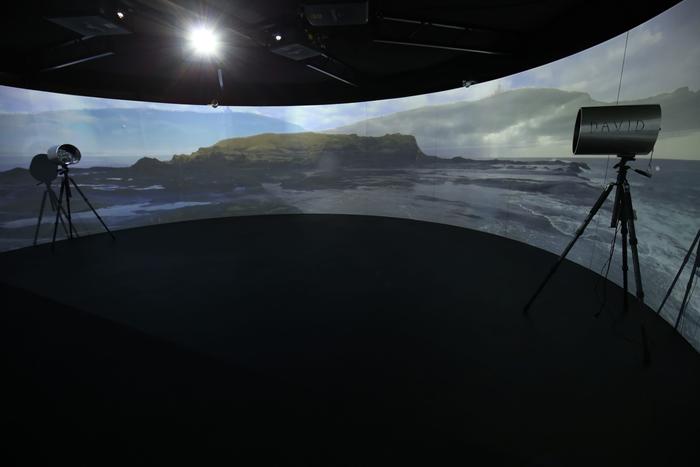
Figure 44: Double exposure effect in Virtual IEIE (Photo: Noriko Koshida)

Figure 45: Double exposure effect of sound beam speakers (Photo: Noriko Koshida)
This last contrivance was a byproduct of something we had been engaging since the early stages of Side Project: to build a collection of short stories related to the history of IEIE, as well as to collect new stories while attempting to realize IEIE in Hokkaido.54 I had become interested in stories as a means of understanding and reflection for this project, ever since I discovered that John Cage’s famous lectures that consisted of nothing but stories were an idea that Tudor first gave him.55 I could see how Tudor would be fond of a performance like that, since stories are modular units of narrative, each constituting an island of sorts, quite similar to the modular instruments that he built and connected for each performance. That is to say, his setup always resembled an archipelago. [Figure 46, 47] And this might explain the common ground connecting all the ideas conceived for IEIE, which was to seek ways to make the giant instrument reflect upon itself through many return paths in the minds of wandering visitors—if a single island multiplied, it could indeed form a virtual archipelago.
54 The collection of our stories is accessible online, although the content is only in Japanese yet: Side Project, “side-effects 2022–2024,” Scrapbox, https://scrapbox.io/side-effects/.
55 As Cage reflected on 16 March 1960: “Once, when I was about to write a lecture, David Tudor said it would be interesting if you wrote a lecture which consisted of nothing but stories. I wasn’t immediately prepared to put that into effect.” (“John Cage and David Tudor, Interview with Gordon Mumma and Ed Burroughs, WUOM radio, Ann Arbor, May 16, 1960,” CD4 Interviews, CCM Archive, Mills College).
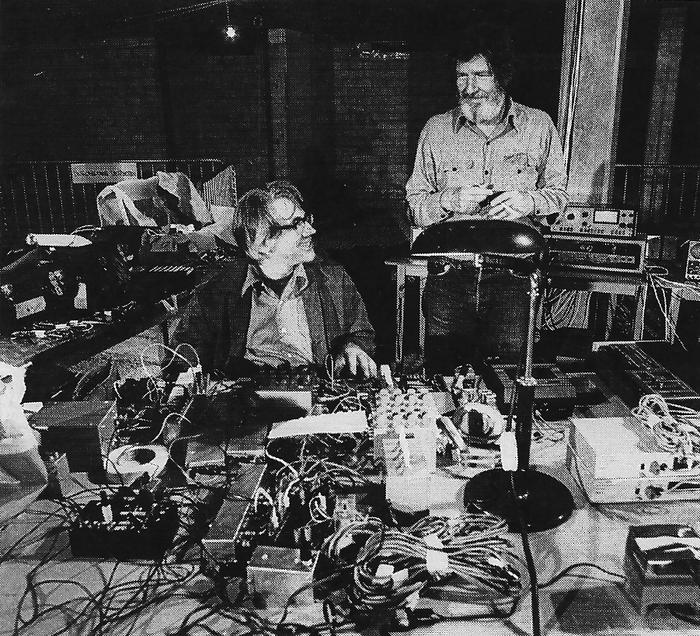
Figure 46: Tudor’s setup of Untitled (1972) (Photo: Peter Stöckli)
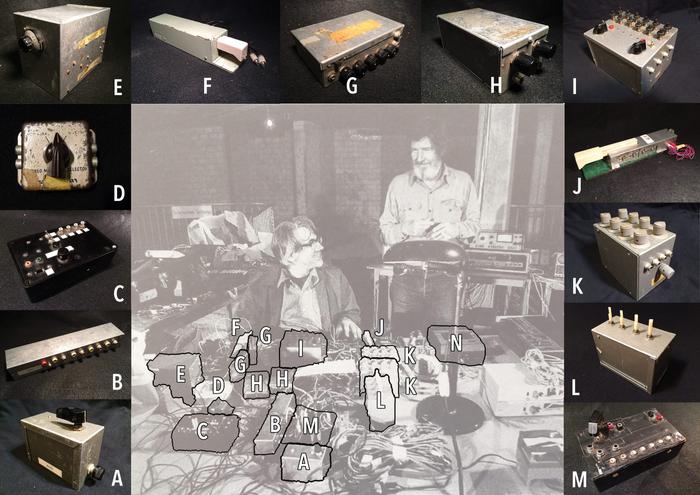
Figure 47: Identification of individual instruments in Tudor’s setup of Untitled (created by You Nakai)
On 11 September 2017, I gave a lecture at the Anthroposophical Society in Oslo. It was an occasion staged by Fujiko Nakaya, who was also in Norway at the time to install her fog sculptures and wanted me to come over to play the role of interpreter to Kenjiro Okazaki, who was appearing with her in a panel discussion. I had initially replied saying I cannot join her this time since I had already made plans to travel to Argentina. But then, Fujiko met two members of the board of Anthroposophical Society in Norway—Dag Blakkisrud, then director of Biological-Dynamic Society, and Tinken Hilde K Laurantzon—over dinner in Oslo one day, and knowing my interest in David Tudor, who spent a lifetime studying the teachings of anthroposophy, arranged for me to deliver a lecture at their headquarters. Now it was an invitation I could not refuse, so I canceled my trip to Buenos Aires and took a flight to Norway instead.56
After the lecture, I had a late dinner with several people, one of whom was Fujiko’s assistant for this project, a filmmaker named Noriko Koshida. We were staying at the same hotel and had met a couple of days ago, briefly talking in between one event and another during a busy weekend. She was around my age and we seemed to get along well, but there appeared to be nothing more to it. On our way back to the hotel from the restaurant that night, we happened to walk across Eidsvoll Square at the center of Oslo. There was an outdoor screen playing the news. It happened to be the night of parliamentary elections and the reporter was announcing the winners. Soon the camera switched from the studio to a live feed from some place outdoors where an elected candidate was parading triumphantly followed by a crowd of people. After staring at the screen for some time, I suddenly realized that the same crowd of people was marching right next to us, going into the stately building facing the square—a building that turned out to be the Norwegian Parliament. The site I thought was being live-fed across a distance on television was the actual place I stood.
As soon as I got excited about the uncanniness of this situation, which made what I deemed as reality feel virtual, I noticed that there was one other person in the group who seemed fascinated by this double exposure of what appeared to be two distinct realities. That was Noriko. We looked at each other, both a bit surprised that there was somebody who would be equally excited about this. We spent the rest of the evening talking at the hotel bar until morning came and it was time for us to part. But we kept in touch and now have two small children between us.
Every year on 11 September, we go to celebrate our anniversary at a nice Swedish restaurant we found in Tokyo. We certainly know that Oslo is the capital of Norway, but since there was no Norwegian restaurant nearby we decided that Swedish was good enough—after all, they were neighboring countries in Scandinavia. That made them virtually the same thing as far as we were concerned.
In July 2022, I was in Berlin as part of Unexpected Territories, a week-long festival of David Tudor’s music. One of the several events I was involved in was a three-hour symposium on IEIE during which I retold the story of missing feedback as well as the story of missing islands.57 Marianne Hultman, whom I had met five years before in Oslo as the curator of Fujiko’s project,58 happened to be in the audience. After I told her about the recent developments in Hokkaido, she told me she wanted to invite the project to Lofoten, an archipelago in Northern Norway where she had just moved from Oslo. Marianne had assumed the role of the director of the Northern Norwegian Art Centre, which organized a biennale in the area called Lofoten International Art Festival (LIAF). Being an archipelago, there were naturally a lot of islands in Lofoten, and extending IEIE, Reflected from SIAF to LIAF sounded like a good plan. 2024 marked the fiftieth anniversary of the first expedition to Knavelskär, and although Norway was not Sweden, commemorating the anniversary in Scandinavia seemed like a good return path.
But when I actually visited Lofoten one summer later in August 2023 to look for an island, I was in for a shock. For when I told people the story of meeting Noriko in Oslo and our subsequent anniversaries at a Swedish restaurant, everybody complained that Norway and Sweden are two very different countries with very different histories, cultures, and human temperaments, to say nothing of the language. They were not to be mixed. Only Marianne, a Swede living in Norway, said she was very happy about our choice especially since she had also played a huge part in staging our meeting in Oslo by inviting Fujiko over in the first place.59 Differences and similarities were optical effects, and the optics differed according to the distance of observation, which usually corresponded to differences of resolution: things that look similar from afar revealed their differences from nearby.60
But when I revisited Kamomejima immediately after my return from Lofoten, something strange happened. I began to notice all kinds of similarities between Esashi and Lofoten, from the fishing industry to the use of islands as military forts, extending to the complex relationship between mainland settlers and indigenous people known respectively as the Ainu and the Sami, and the uncanny resemblance between triangular wooden structures that are used in Svolvær to dry fish, and the bare wooden structure of a house in Esashi that was blown away by strong wind that Matsumura had captured in a series of photographs back in the 1960s. [Figure 48, 49] In other words, the two localities that looked quite different from afar were revealing their similarities from nearby. Just as the focus on Kamomejima had revealed its unexpected connection with Kaga, the focus on Esashi and Lofoten was making them merge through reflection. Of course, I was no longer in Norway, so what I was comparing were the images in my memory and the scenery that spread before me, a bit like the virtual double exposure Julie Martin had created on her revisit to Knavelskär, except this time the distance was spatial rather than temporal. It was still a matter of optical effects, but the effects were now distributed across multiple scales of resolution nested inside one another. Things that looked similar from afar had indeed revealed their differences from nearby—but a further close up had the effect of fabricating a virtual coherence.
56 I gave a lecture titled “Musica Instrumentalis: David Tudor and the Occult Passage of Music” about the influence of anthroposophy on Tudor’s conception of music and instruments, which I later incorporated into the chapter on Island Eye Island Ear in my book Reminded by the Instruments, Chapter 6.
57 The other participants in this symposium were Julie Martin, Jacob Kierkegaard, Phil Edelstein, and John Driscoll.
58 Marianne has created a beautiful book documenting Fujiko’s multifold projects in Oslo: Jonatan Habib Engqvist and Marianne Hultman, eds., Letters Sent from Heaven: Frozen and Vaporized Water. Ukichiro Nakaya and Fujiko Nakaya’s Science and Art (Oslo: OK BOOK, 2022).
59 Marianne also reminded me, after reading the draft of this article that Billy Klüver’s father was Norwegian, making him a Swedish-Norwegian.
60 I also recalled how when I was growing up in Mexico, most of the people around me seemed to imagine Japan, Korea, and China as one thing, which would appear as a sign of ignorance for many Japanese, whereas the people in Japan were oblivious to the difference between Mexico, Belize, and Guatemala, which was very important for many Mexicans.
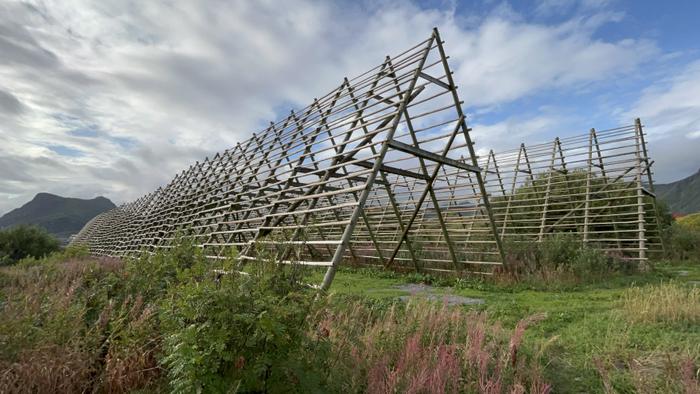
Figure 48: Triangular structures for drying fish in Lofoten (Photo: You Nakai).
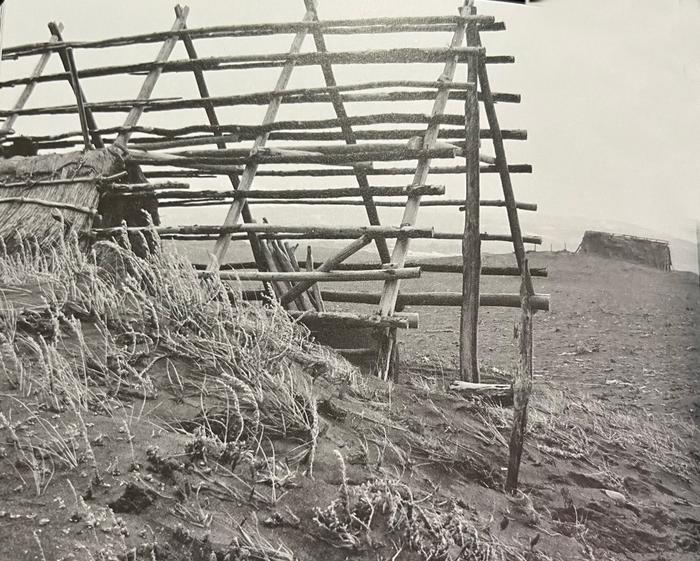
Figure 49: Triangular structure of a house blown away by wind in Esashi (Photo: Takashi Matsumura)
It occurred to me that perhaps this was what the seventeenth-century English poet John Donne was reflecting upon when he wrote his “Meditation XVII” in 1626—shortly before the political and social unrest that was to wreak havoc on his native island and release all the virtuosos to the street—which included the famous passage about there being no such thing as an island:
No man is an island,
Entire of itself;
Every man is a piece of the continent,
A part of the main.
[…]
Any man’s death diminishes me,
Because I am involved in mankind.
And therefore never send to know for whom the bell tolls;
It tolls for thee.61
Writing twenty-six years after De magnete, Donne may well have been aware of how the term virtus was used in contemporary thinking. And if one resorted to that term, he could be paraphrased as saying that all islands are virtual, matters of effect produced by the condition of surrounding waters—as a matter of fact, all islands are connected underwater. But at the same time, the poet appeared to be saying something else too, since he also focused on the individuality of each death and a bell that tolls for thee, as if to suggest that it is only through the specifics of each island that their unexpected continuity is revealed. Underwater connection is itself a virtual coherence because without the mirage of individual islands there will be nothing to connect. Matters of fact are thus predicated on the condition of being situated in one specific location in time and space.62 [Figure 50]
61 John Donne, “Meditation XVII,” Devotions upon Emergent Occasions, 1626.
62 When Marianne came to Hokkaido in November 2023 to witness the Kamomejima test run, along with Kjersti Solbakken and Berte Ynnesdal, the curator and producer of LIAF, they also began reflecting on the connections between Lofoten and Esashi. I decided to name the symposium we held together in Sapporo after Donne’s phrase, twisting it a bit to make it more inclusive: No Wo/Man Is an Island.
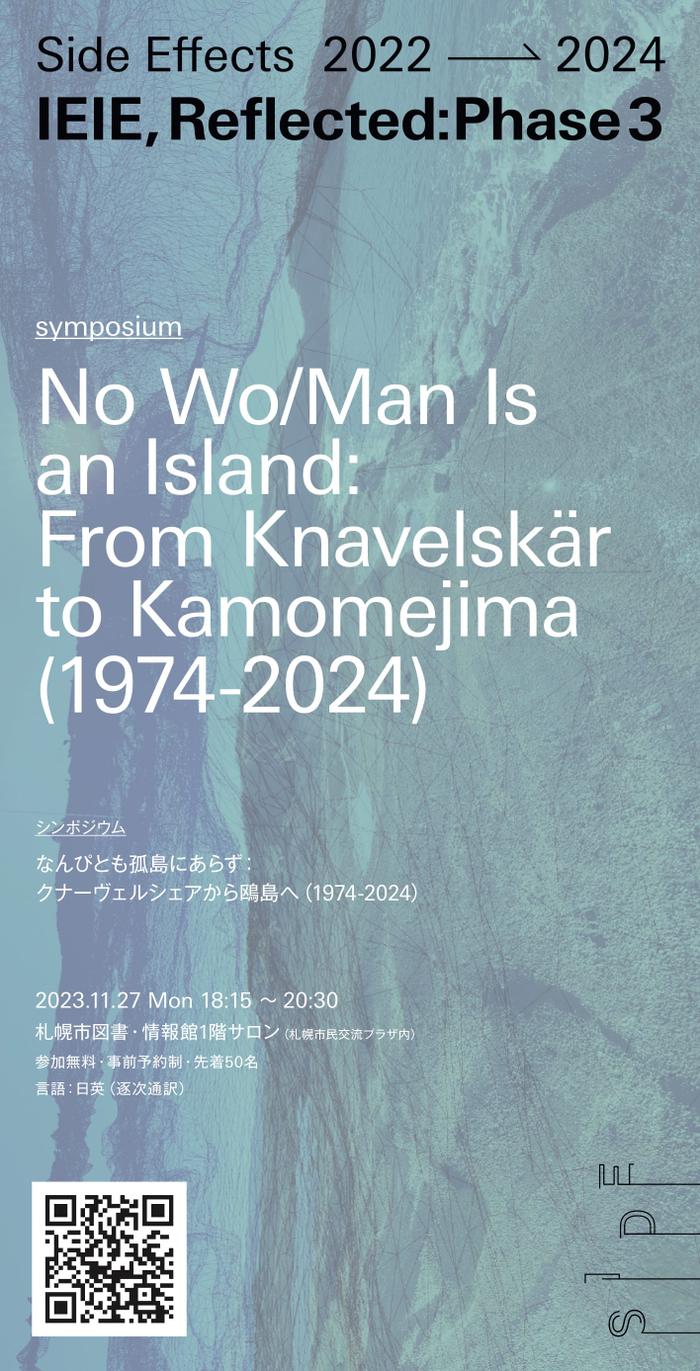
Figure 50: Flyer of IEIE, Reflected: Phase 3 | No Wo/Man Is an Island (2023) by Side Project
And as it is for an island, so it is for a story. The perimeters of a story are just as virtual as the perimeters of an island. But there is nevertheless a certain feeling of coherence. And it is by focusing on the specifics of this virtual individuality that you might find common undercurrents connecting narratives that appear to have nothing to do with one another on the surface. The age-old problem with stories, however, is that people tend to forget that they are stories. Then they either generalize too much and become oblivious to differences that only appear from nearby, or do not generalize enough and become oblivious to similarities that only appear from afar. In either case, stories have consistently received a bad name for being a distorted representation of reality that cannot be rendered into a story.63 Boyle was certainly not the first person to mistrust the narrative that people superimposed on matters of fact. Plato’s plan to ban all poets from his Republic of philosopher-king ran by logic and reason alone is another notorious example.64 But we all know that what Boyle and Plato had to offer in the place of stories was just more stories.
So there is a rich heritage of stories subsuming stories in which one side pretends to not be a story. In reality it is often difficult to keep the two sides apart. And since the important thing about heritage is that it cannot be preempted, let me conclude with a surprising reflection that my son Aevi made when he was six years old, which opens a return path from the virtual nature of stories to the potential of byproducts for establishing unexpected connections with the not yet.65 He came back from school one day and told me, as if it were a matter of fact—“I like stories because I don’t know what’s going to happen.”66
63 There is a long lineage of criticism against the dangers of stories. For some recent examples, see for instance Jonathan Gottschall, The Story Paradox: How Our Love of Storytelling Builds Societies and Tears Them Down (New York, NY: Basic Books, 2021); or Alex Rosenberg, How History Gets Things Wrong: The Neuroscience of Our Addiction to Stories (Cambridge, MA: MIT Press, 2019).
64 Plato, Republic, translated by Christopher Rowe (London: Penguin, 2012).
65 Aevi’s name in Chinese characters means “already not yet,” which I also used for the name of the experimental publishing project that my group, No Collective, has been running. For details, see https://alreadynotyet.org/ and https://nocollective.com/.
66 Aevi Nakai Gluzman, personal communication, May 2017.
You Nakai, “IEIE, Reflected, Reflected,” Metode (2024), vol. 3 ‘Currents’
